Felix Gumshoes Again
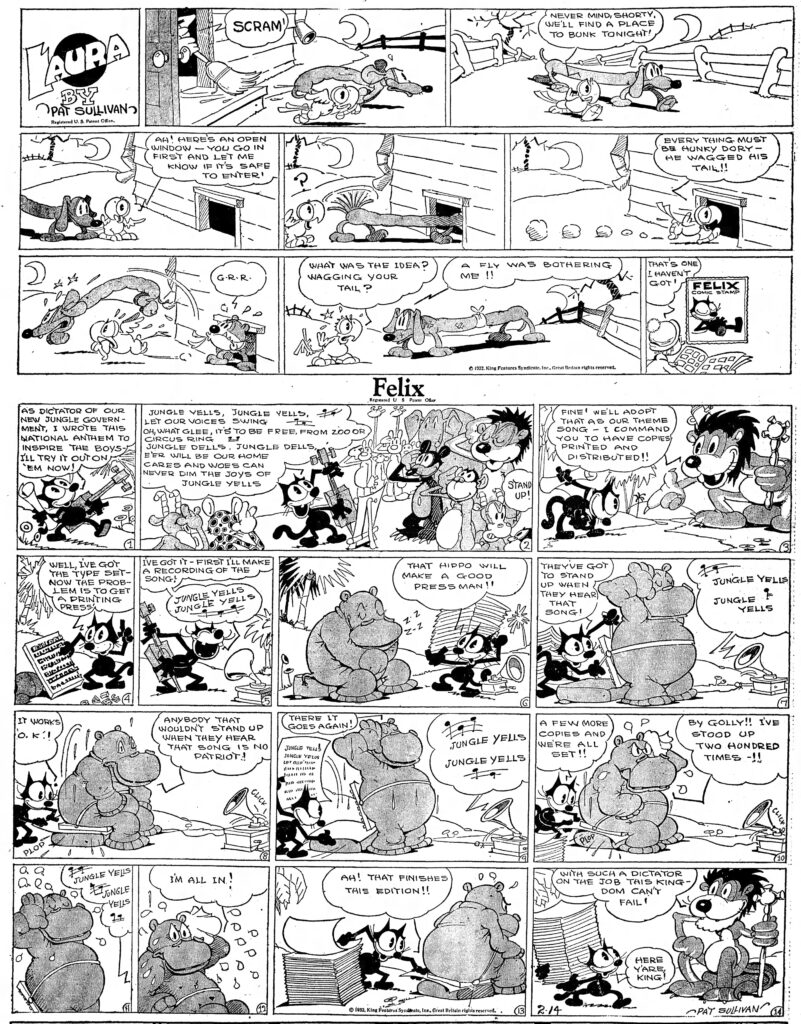
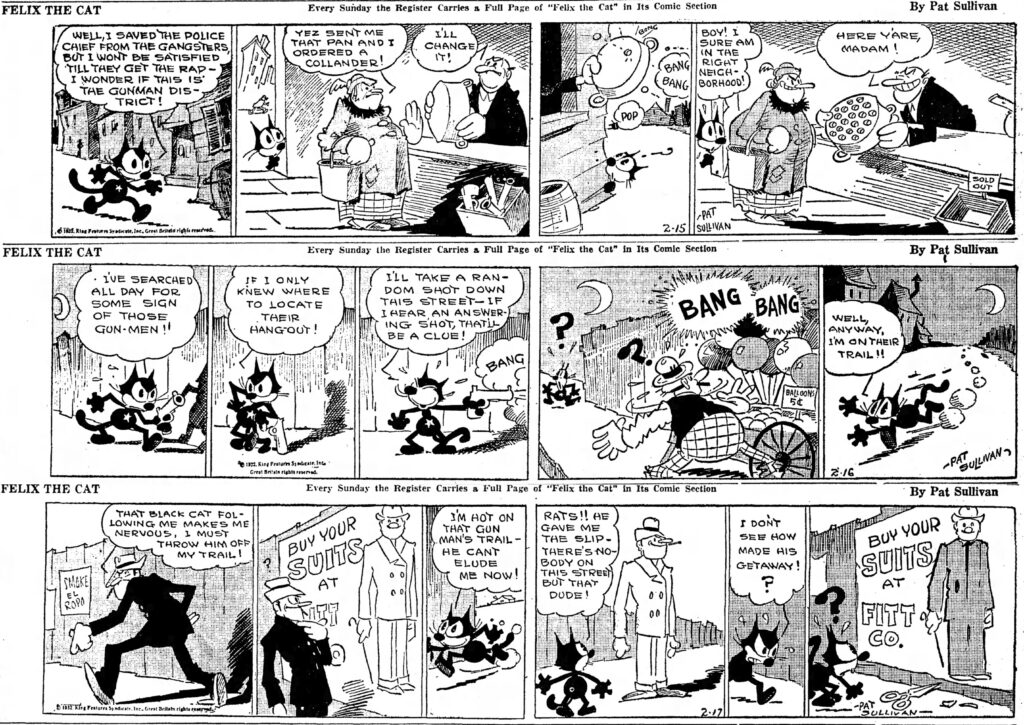
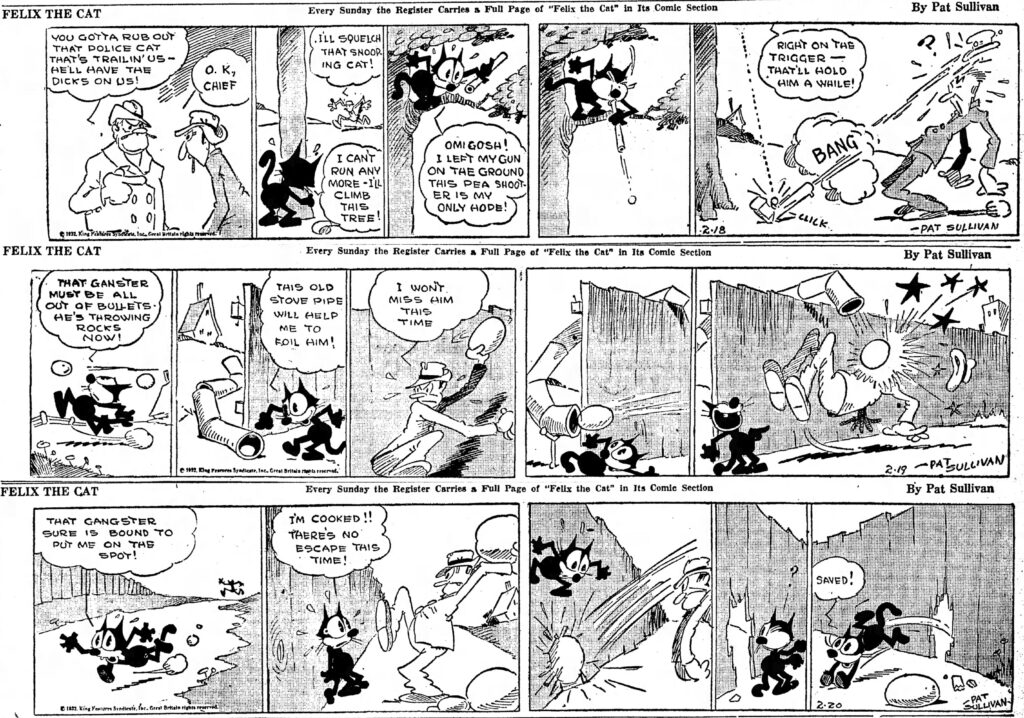

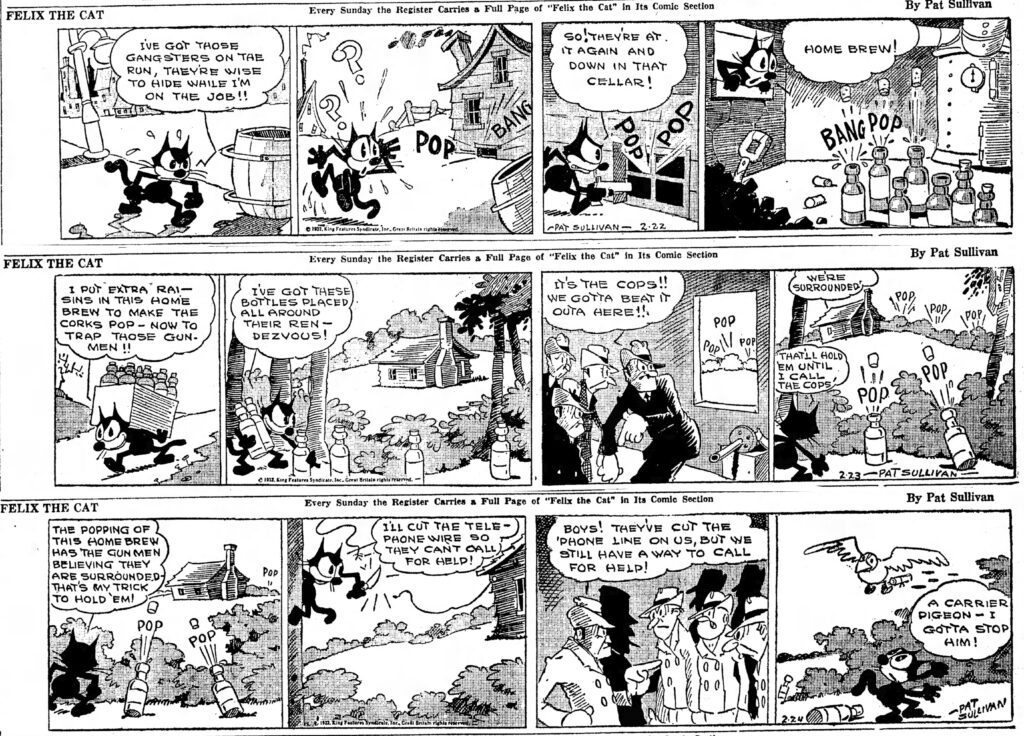
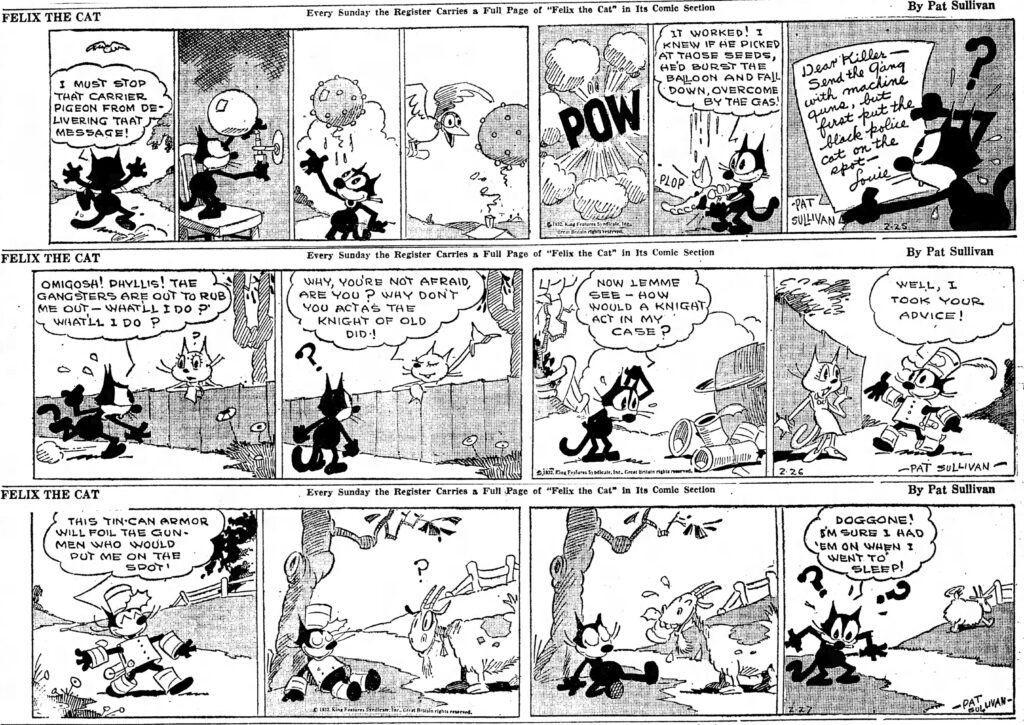
The Catblog presents Felix at his best in the strips from 2-14 to 2-27-1932! My favorites are the 2-19 and 2-20 dailies as the gangster is clobbered with his own rock in the former (Love that Felix pointing and laughing pose) and Felix deftly popping through a hole in the fence in the last panel of the latter. Prohibition is referenced in the 2-22 and 2-23 dailies as Felix says “I put extra raisins in this home brew to make the corks pop..”. There is an Aesop Fable cartoon from 1923 called “The Fable of A Raisin and a Cake of Yeast” which were the main ingredients of home made beer, so the recipe was well known in the era of the Great Experiment. We also learn that Felix’s Girlfriend was named “Phyllis” in 1932 as opposed to “Kitty” for so many of the other Felix years. Phyllis is such a wispy little cat, isn’t she? Sorry it’s been more than two months since the last entry around here. I keep busy with my weekly post of “Someday Comics” for the Daily Dose online comics sharing group. But I love to do these blog posts best of all. Have a Happy Thanksgiving everyone!
Felix the Police Cat
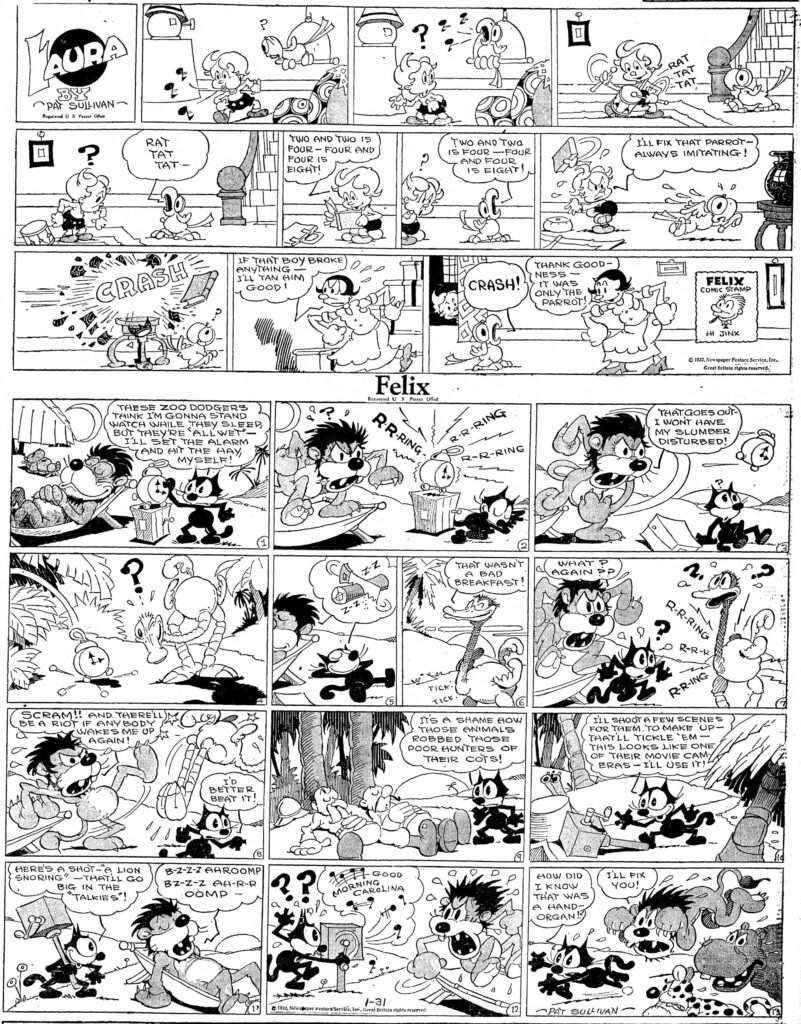
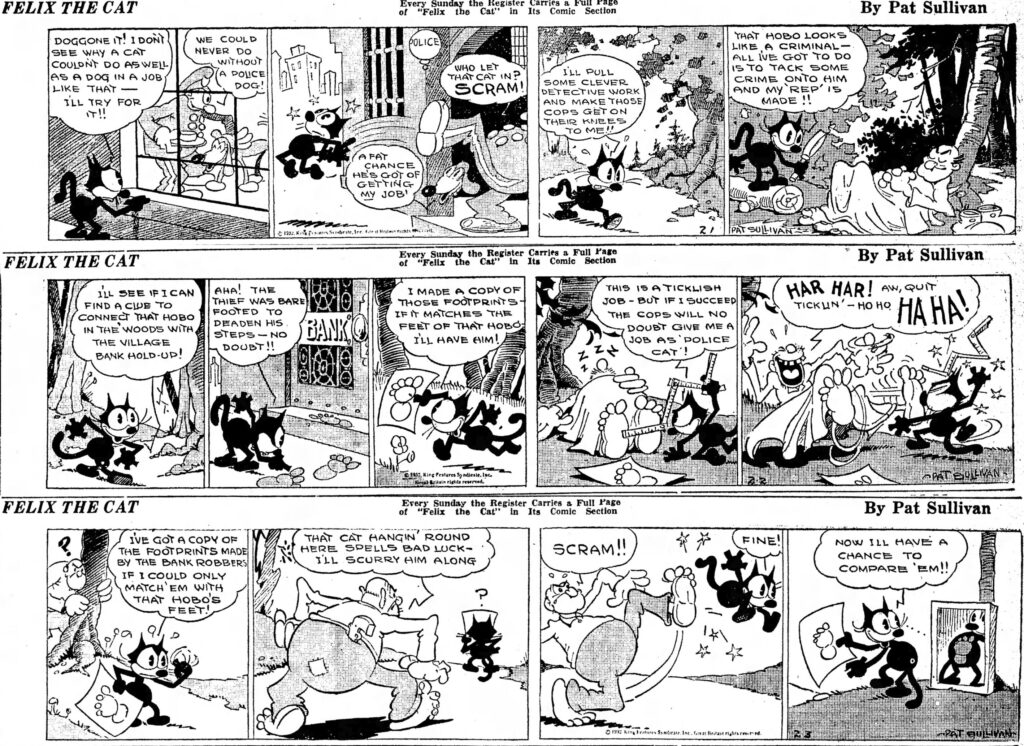

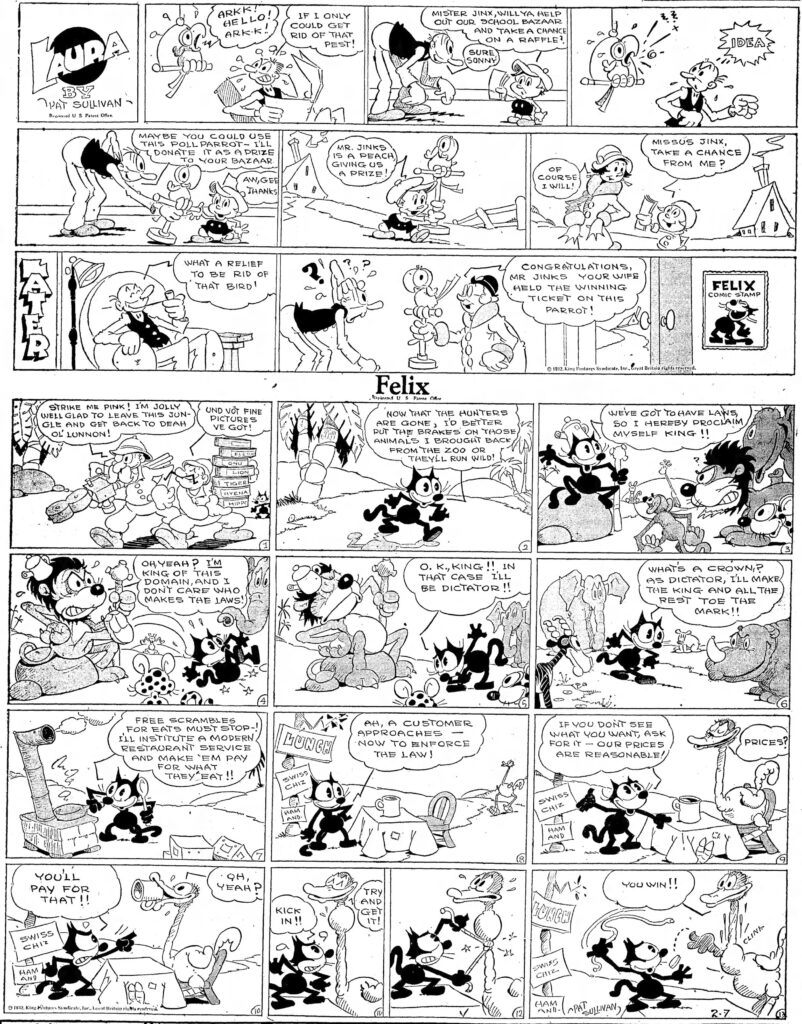
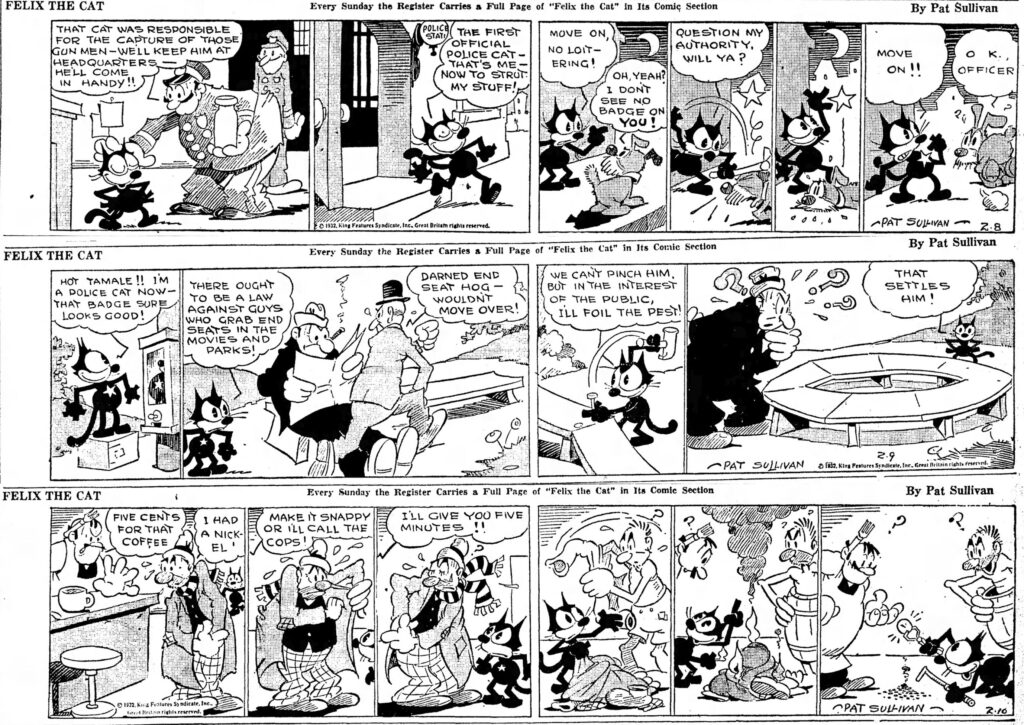
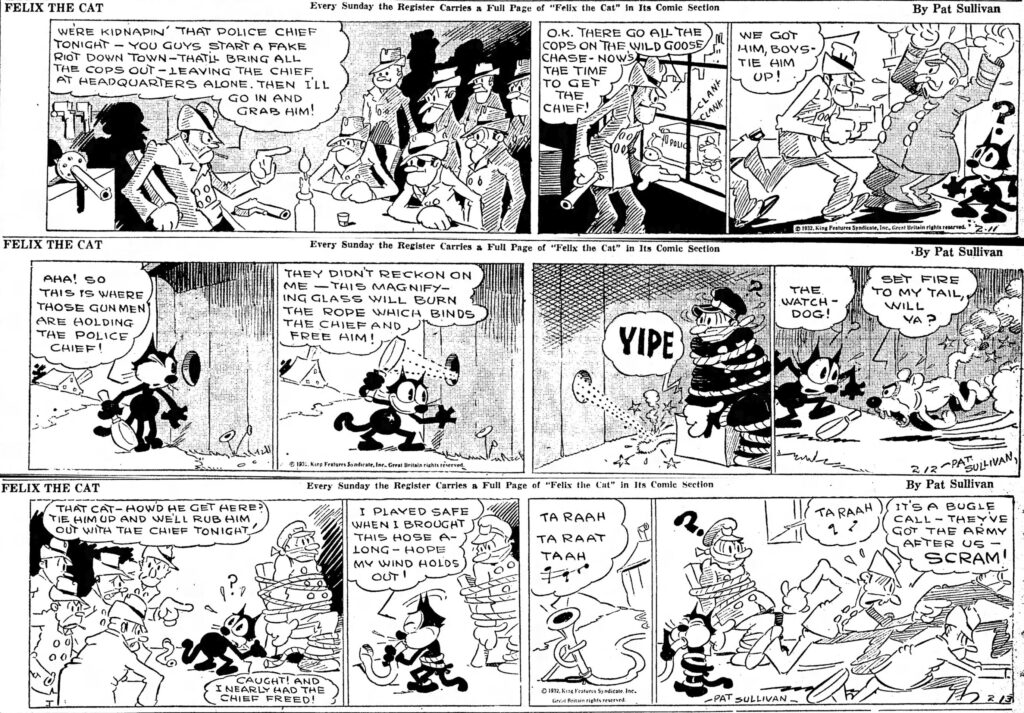
Folks, this time up we have Felix the Cat from 1-31 to 2-13-1932. The Sunday pages continue the adventure of Felix’s Ark, which you can see in color in David Gerstein’s book, “Nine Lives To Live”. The dailies have not been collected, and continue the story of “Felix the Police Cat”. Having secured a place for his friend the dog in the police department, Felix catches the Cop Bug himself, and wants to be a great Police Cat and Detective. The art in these strips is just superb, look at the woods background in the last panel of the 2-1 strip as Felix closes in on the Hobo. I also love the detail on the bank door in the second panel of the 2-2 opus. In the 2-4, second panel, Otto shows a real eye for “noir” shadows on the gangsters, and he repeats the motif in subsequent strips. The angularity of Felix’s elbows really comes in to play in the 2-10 strip, as Felix fishes a nickel out of a hobo’s burned-up clothes. There are many more well-designed and staged panels in these comics, look for ’em! You know how to blow them up, don’t you? Just right-click the image and a pop-up menu appears which says, “Open Image in New Tab”. Click on that, and the comics will appear in a new window, just click on it and you will see enlarged panels. Enjoy, everyone.
Mistaken Identity Mabels
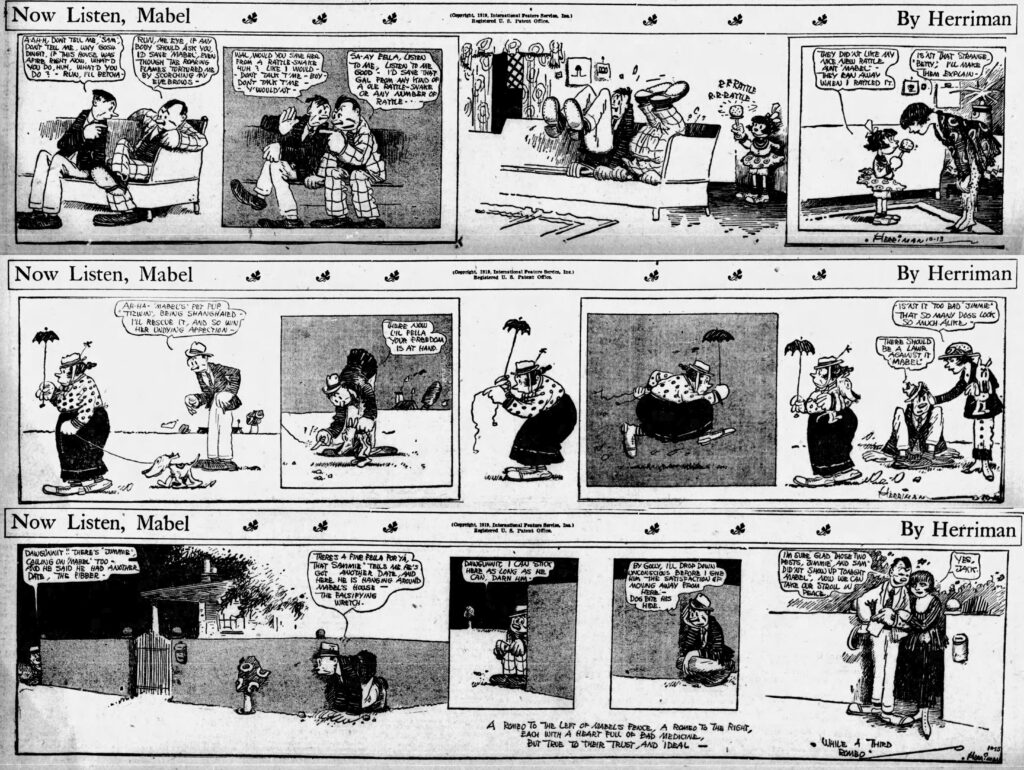
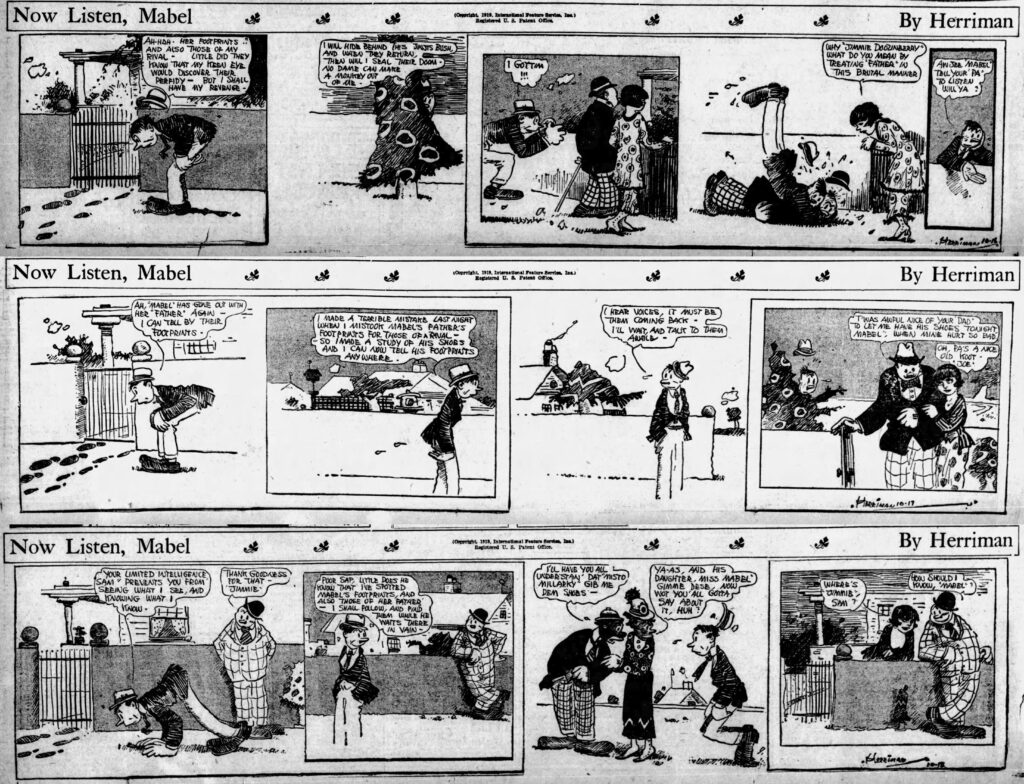
Here’s another week of the rare Herriman daily strip, “Now Listen, Mabel” from Oct. 13-0ct. 18th, 1919. Mabel was also the name of George Herriman’s wife, Mabel Lillian Bridge. The gags here would just about fit Archie and Reggie in the 1940s Archie comic books. Jimmie Doozinberry’s constant wooing of the beautiful Mabel are continuously frustrated and flummoxed. Garge works the “mistaken identity” gags hard in the Oct. 14th and Oct. 16th through the 18th. Jimmie is surprised by a black couple wearing Mabel’s and her Dad’s shoes in panel three of the 10-18. Mabel’s dog “Tizwin” is mistaken for another pooch in the Oct. 14th. As Jimmie and another suitor wait for Mabel in the Oct. 15th strip, Mabel cozies up to a third lover, Jack. The house in the Oct. 15th strip looks a lot like the house that Garge lived in at 2217 Maravilla way in the Hollywood Hills, complete with the low adobe wall in the front of the property. I am unable to come up with a definition of a “Jinji’s Bush”, which Jimmie hides behind in the Oct. 16th strip. It MAY be a Japanese flowering bush from which a tea is made. That’s my educated guess. Can any of my readers help me with this puzzle?
Dance of the Pen by Cathy Hill
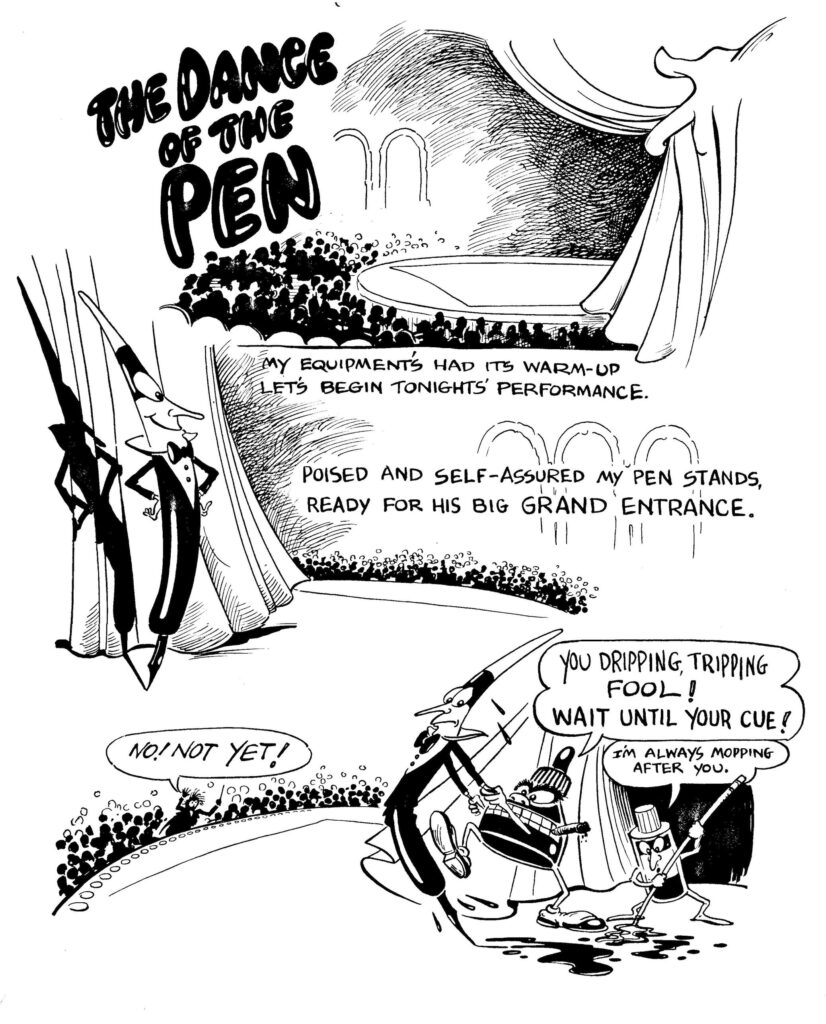 “Dance of the Pen” is
“Dance of the Pen” is
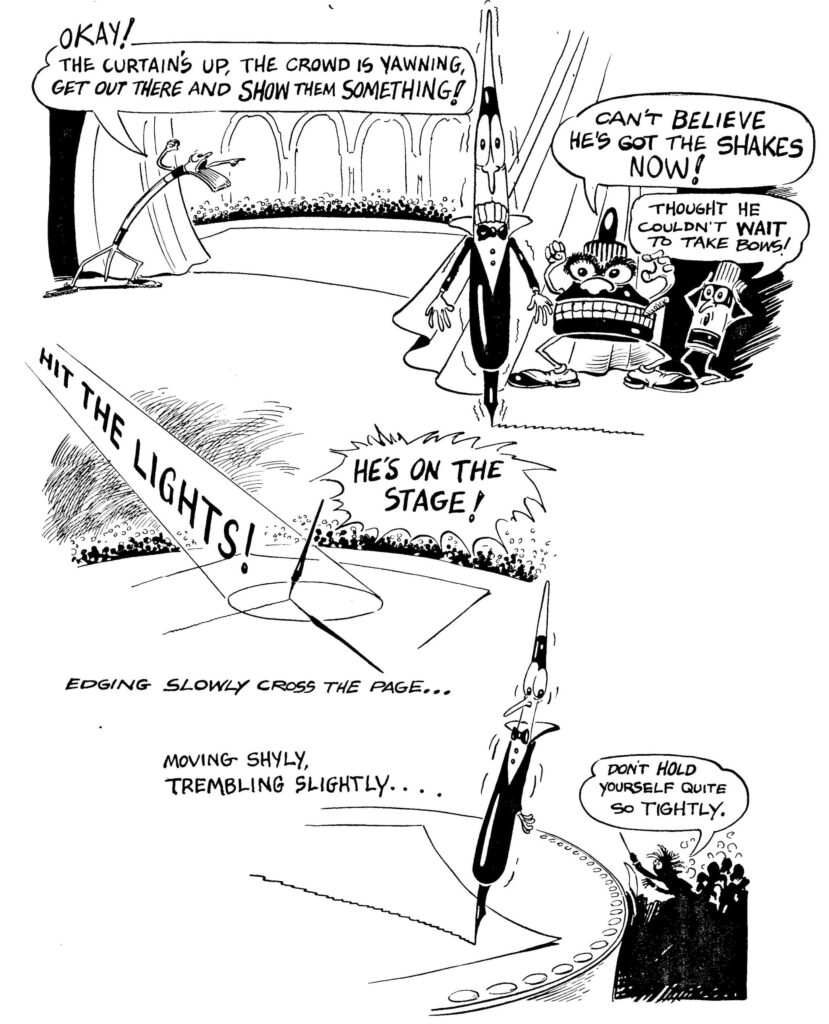
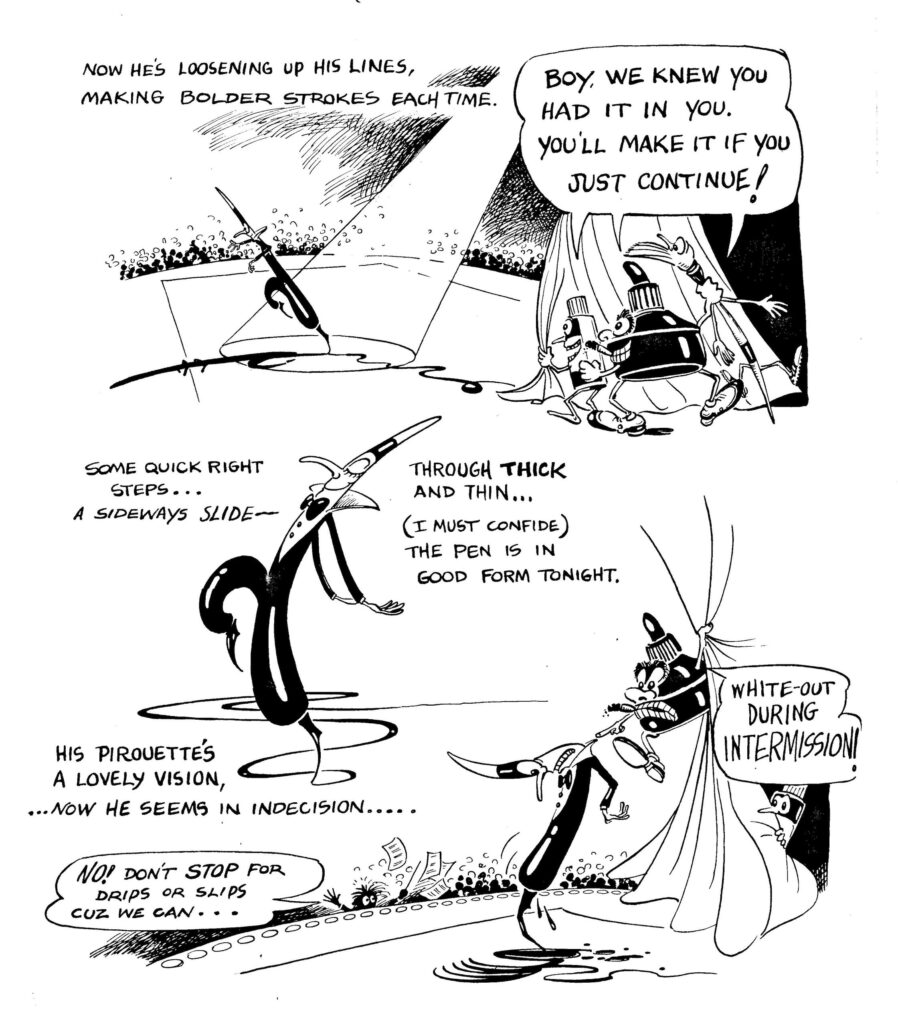
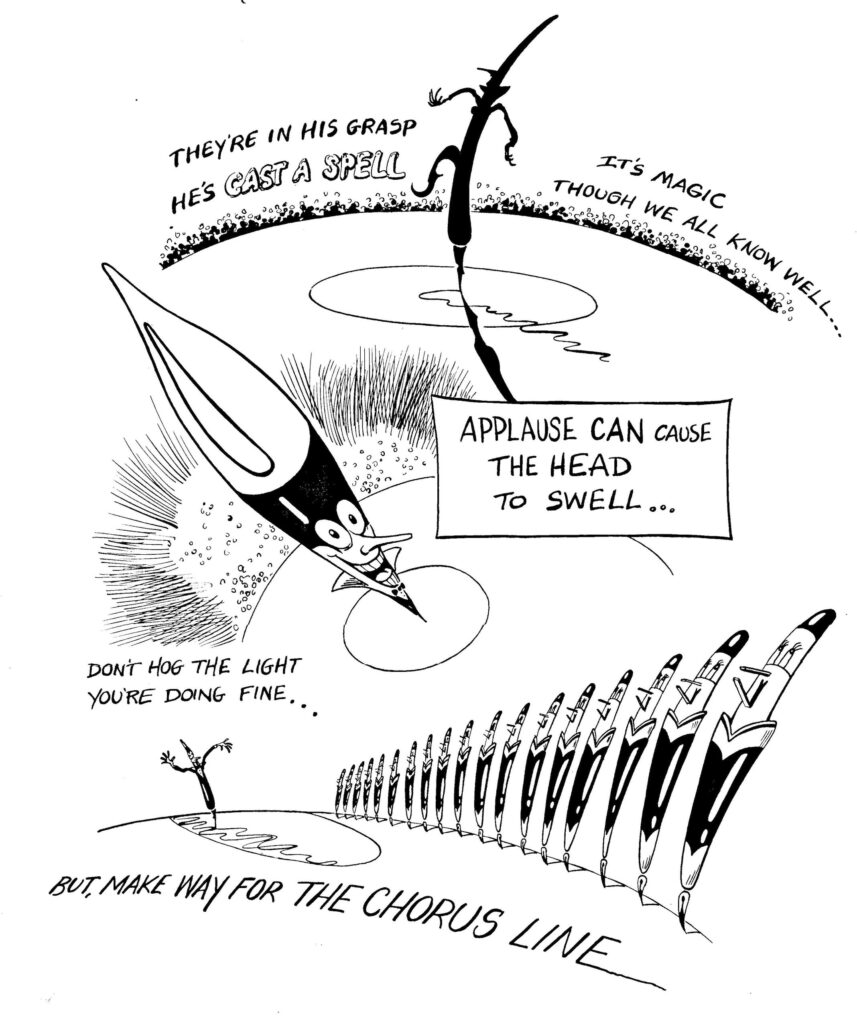
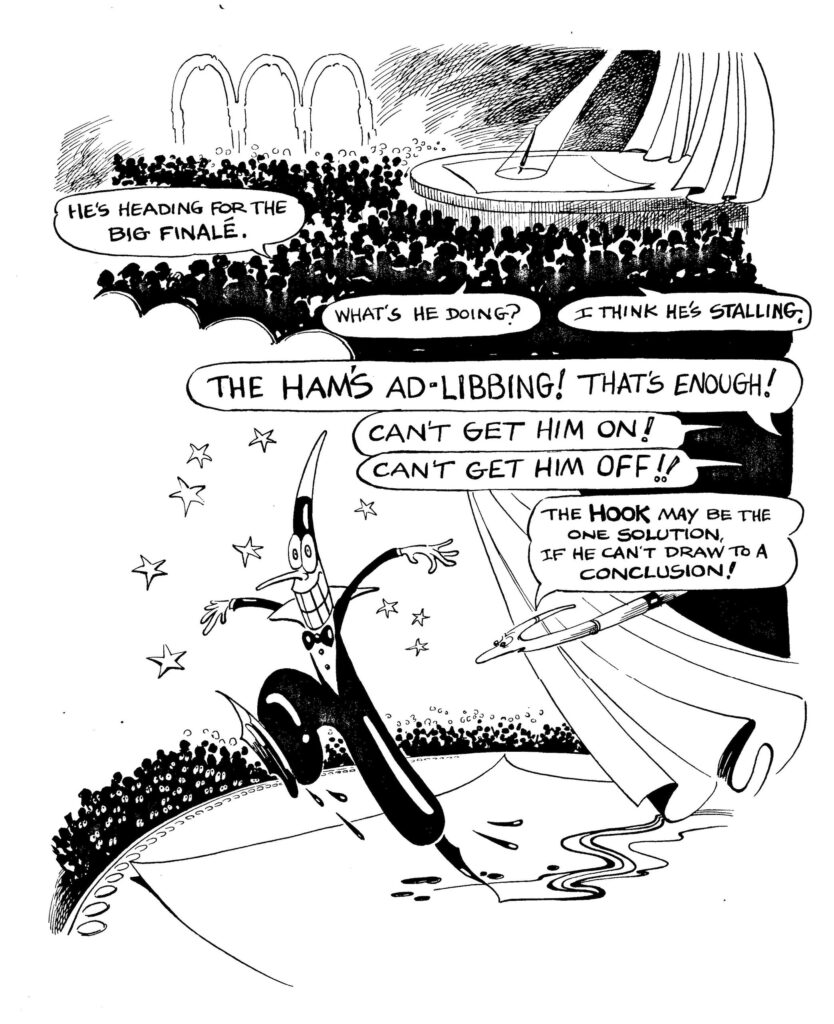
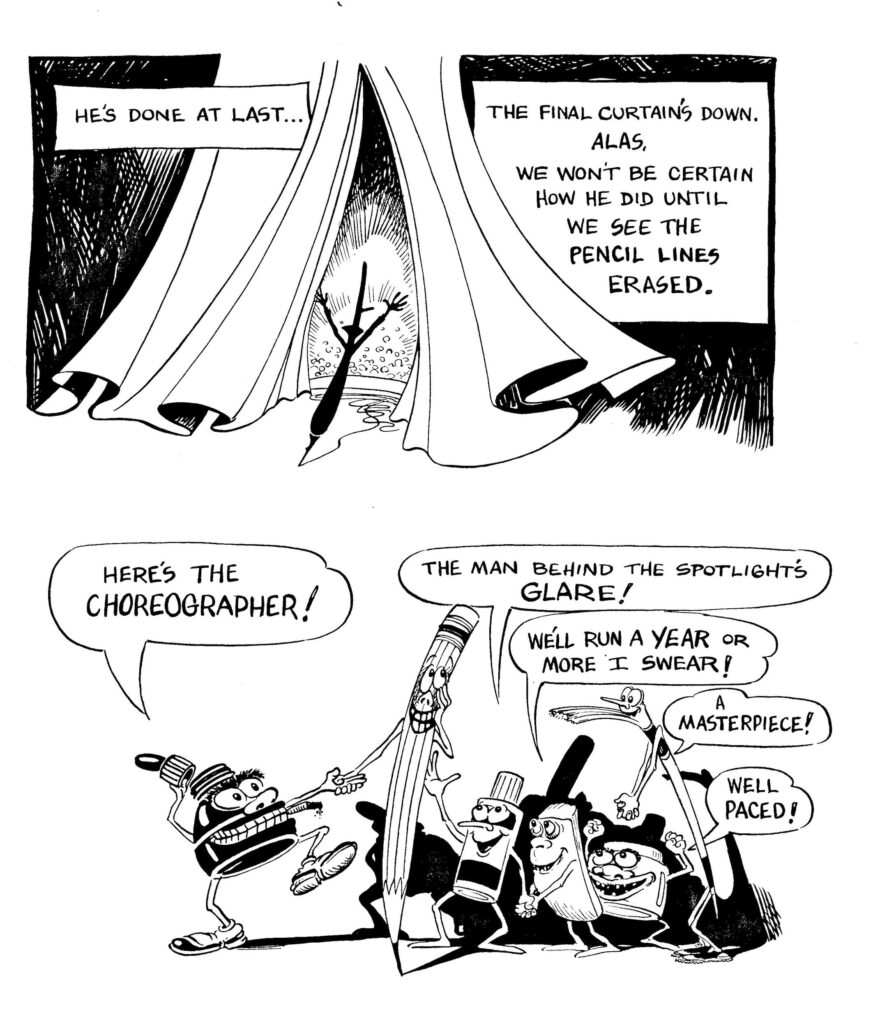
 “Dance of the Pen” is Cathy Hill’s comic tribute to an art supply, the DIP PEN, the holder and the pen point. It’s a tribute, not only to the dip pen, but to a lost art in a world that doesn’t celebrate drawing by hand so much anymore. As you have seen on past posts, Cathy is an experienced artist and handles the recalcitrant and stubborn pen with grace and aplomb. Her lines are exquisite, full of rhythm and scintillating, undulating beauty. Her text is all in rhyme, full of lines that celebrate the experience of an inker, “..a sideways slice–through thick and thin..(I must confess) the pen is in good form tonight.” I love her celebration of the “choreographer” of the page, the pencil! (On page six) “The final curtain’s down, Alas, We won’t be certain how he did until we see the pencil lines erased.” Cathy equates the “Dance of the Pen” to show business; the inkwell and the white out bottle are the pen’s managers. Note the “fans” clamoring for the Pen’s autograph on page Seven as the Pen replies to the autograph hounds, “Thank you, do you have a pen?” My favorite touch is the little car driving off with the Pen and his pals as they say: “Let’s celebrate in noisy joints! The night is going to waste.” Cathy and I often quote this line to each other. I hope you will enjoy the “show”!
“Dance of the Pen” is Cathy Hill’s comic tribute to an art supply, the DIP PEN, the holder and the pen point. It’s a tribute, not only to the dip pen, but to a lost art in a world that doesn’t celebrate drawing by hand so much anymore. As you have seen on past posts, Cathy is an experienced artist and handles the recalcitrant and stubborn pen with grace and aplomb. Her lines are exquisite, full of rhythm and scintillating, undulating beauty. Her text is all in rhyme, full of lines that celebrate the experience of an inker, “..a sideways slice–through thick and thin..(I must confess) the pen is in good form tonight.” I love her celebration of the “choreographer” of the page, the pencil! (On page six) “The final curtain’s down, Alas, We won’t be certain how he did until we see the pencil lines erased.” Cathy equates the “Dance of the Pen” to show business; the inkwell and the white out bottle are the pen’s managers. Note the “fans” clamoring for the Pen’s autograph on page Seven as the Pen replies to the autograph hounds, “Thank you, do you have a pen?” My favorite touch is the little car driving off with the Pen and his pals as they say: “Let’s celebrate in noisy joints! The night is going to waste.” Cathy and I often quote this line to each other. I hope you will enjoy the “show”!
Felix and Snoopy?
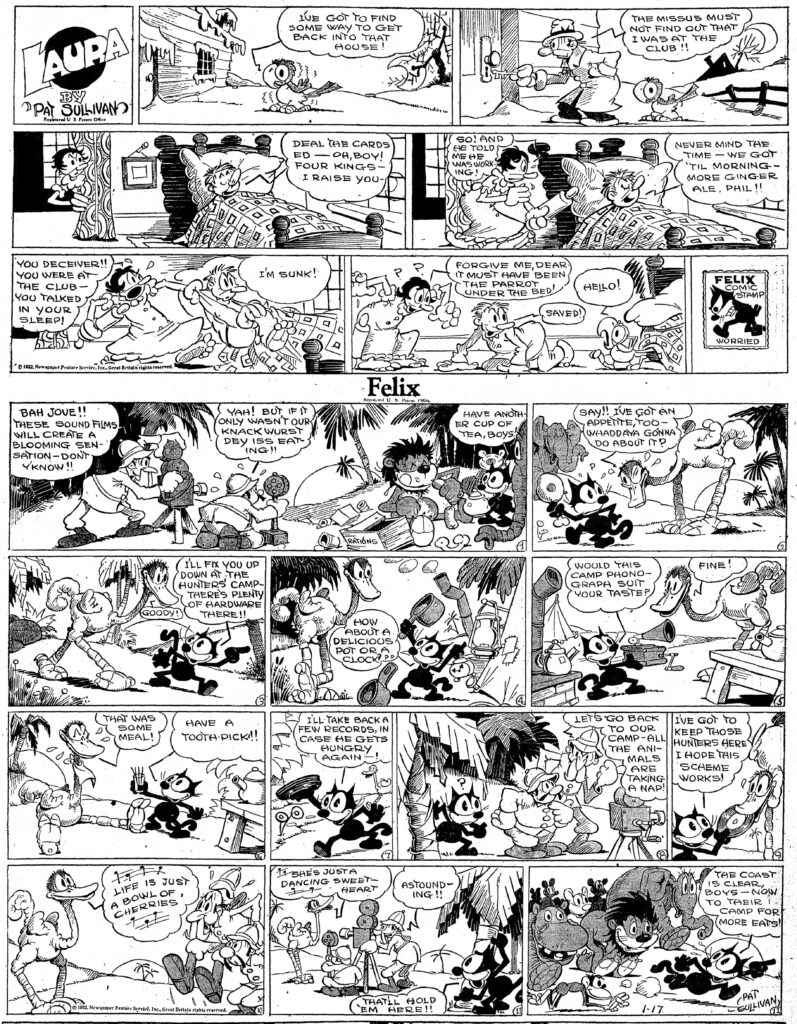
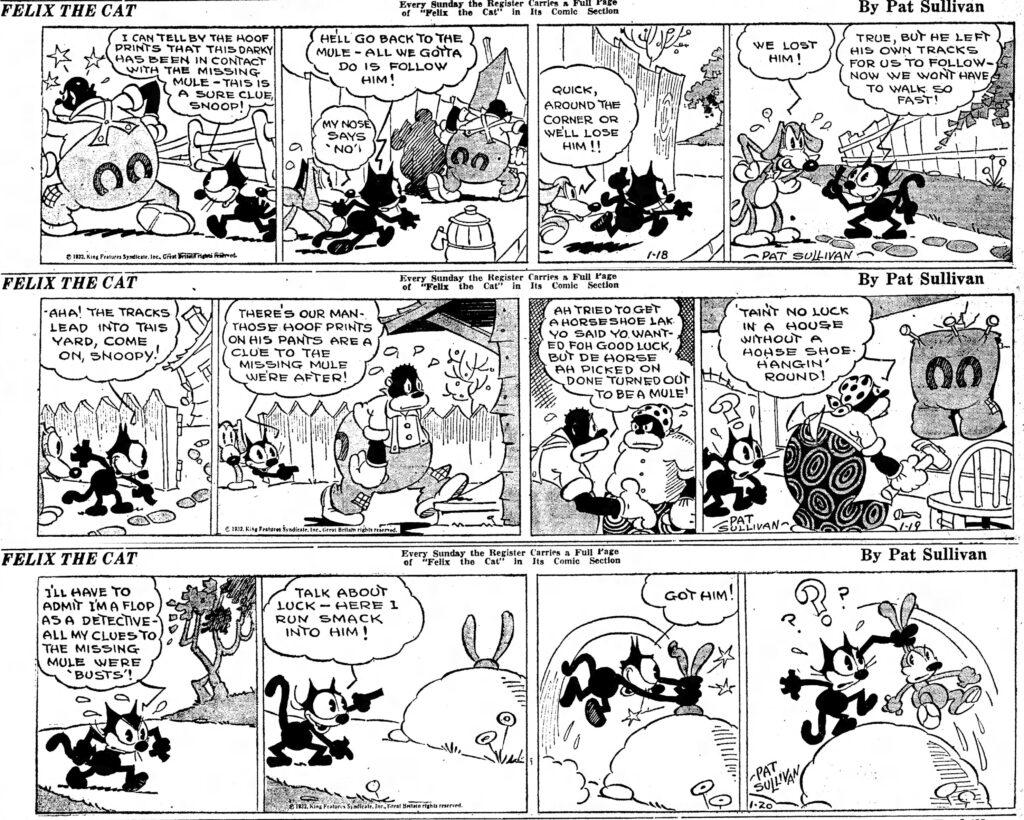
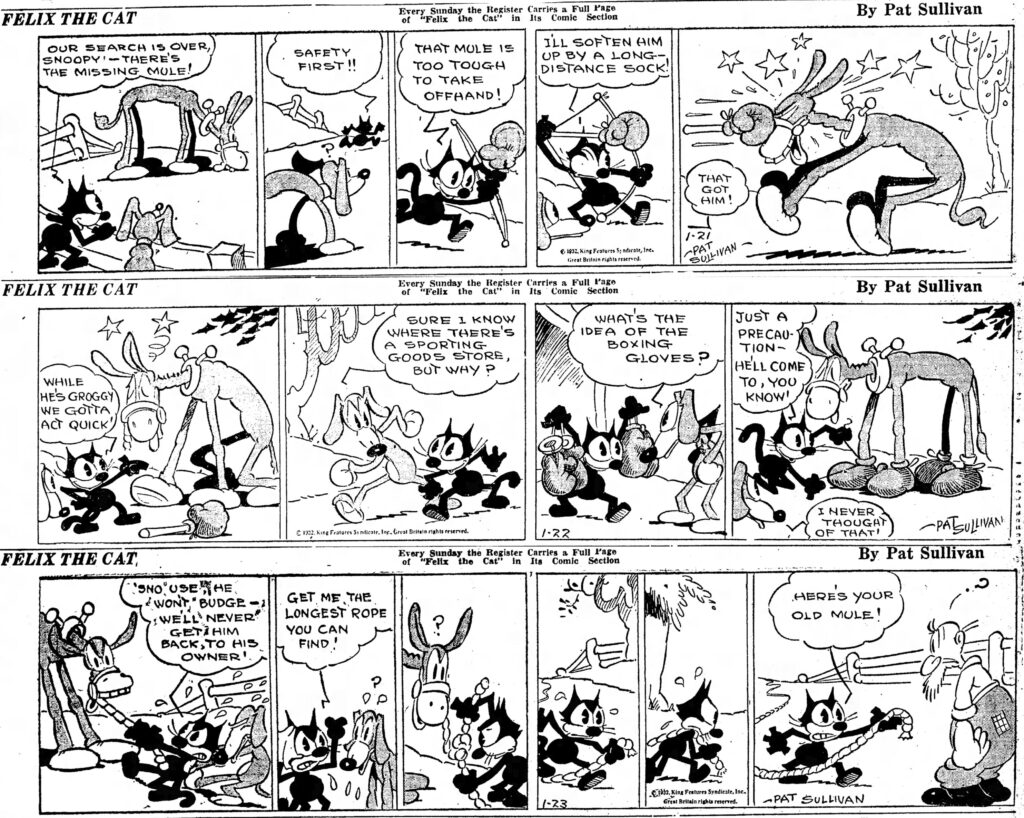
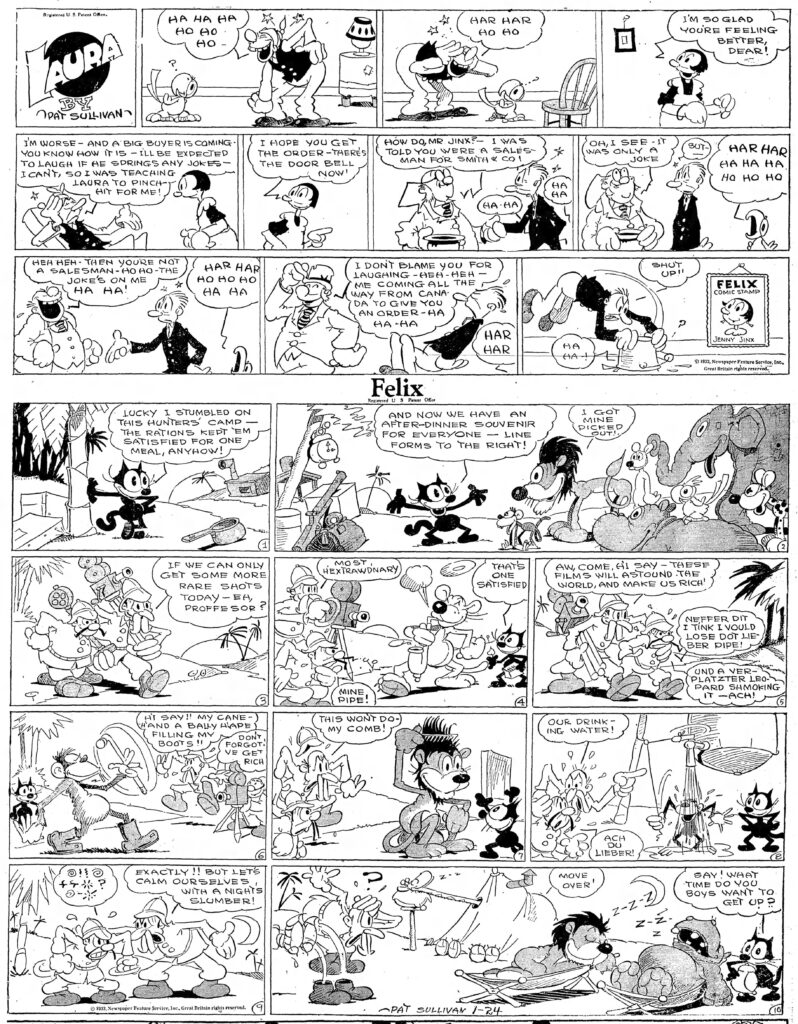
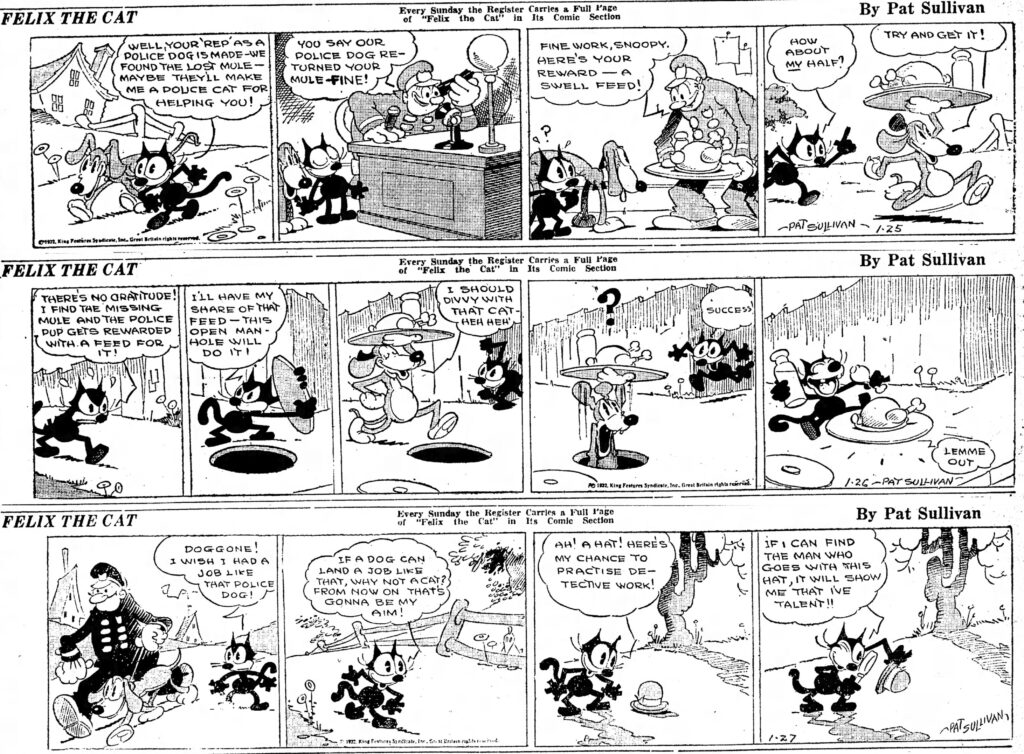
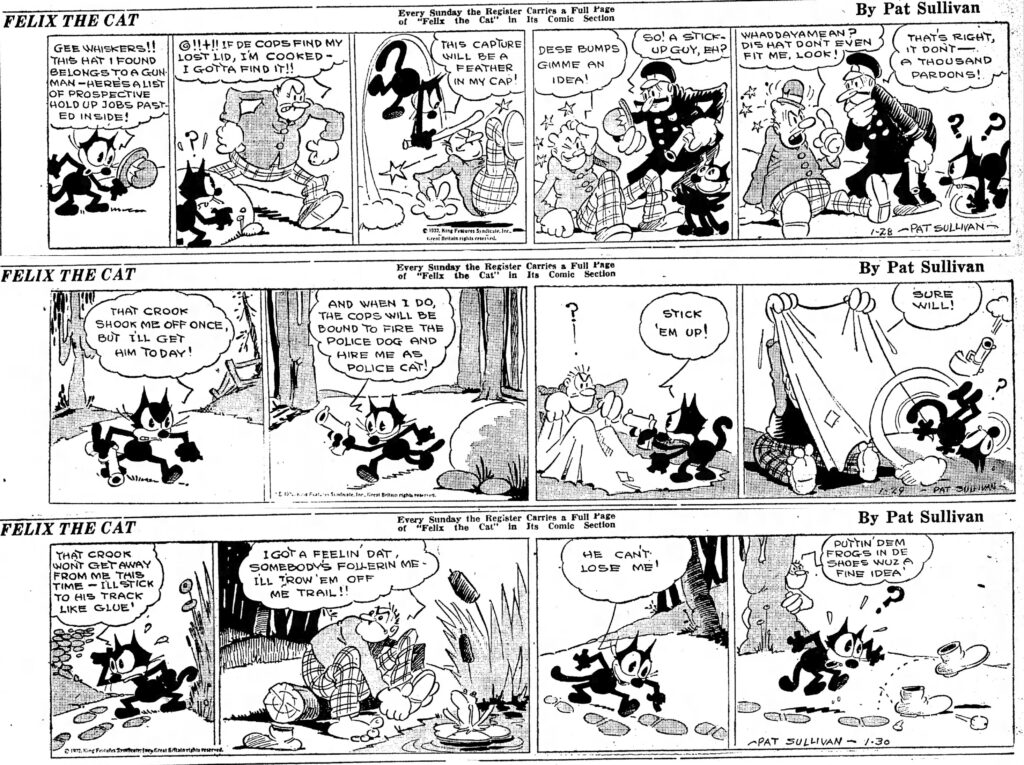
I’m having fun reading these old Felix strips from 19320117 to 19320130. It’s different to see Felix operating as his own “cat” and not in thrall to the Danny Dooit family. The police dog that Felix teams up with is called “Snoopy”, many years before Charles Schulz used the name for his dog creation in “Peanuts”! I wonder if Mr. Schulz may have read this Felix story in his youth and remembered the dog’s name? Felix solves the Missing Mule Mystery in the 1-22 and finds a crook’s derby hat in the 1-27. This clue goads Felix in to a totally independent investigation and he pursues his man as a full-fledged ‘Police Cat”. Is that a “gat” in his had in the 1-29, or just a “gitten”? I love that frog on the lily pad in the 1-30, perhaps he’s an ancestor of Flip the Frog! The Sunday pages are the last chapters of “Felix’s Ark”, a story begun in 1931. Find a copy of David Gerstein’s “Nine Lives To Live”, to see the entire Sunday continuity in color. Until next time, “Right-e-O!”
Mabel and Her Pups
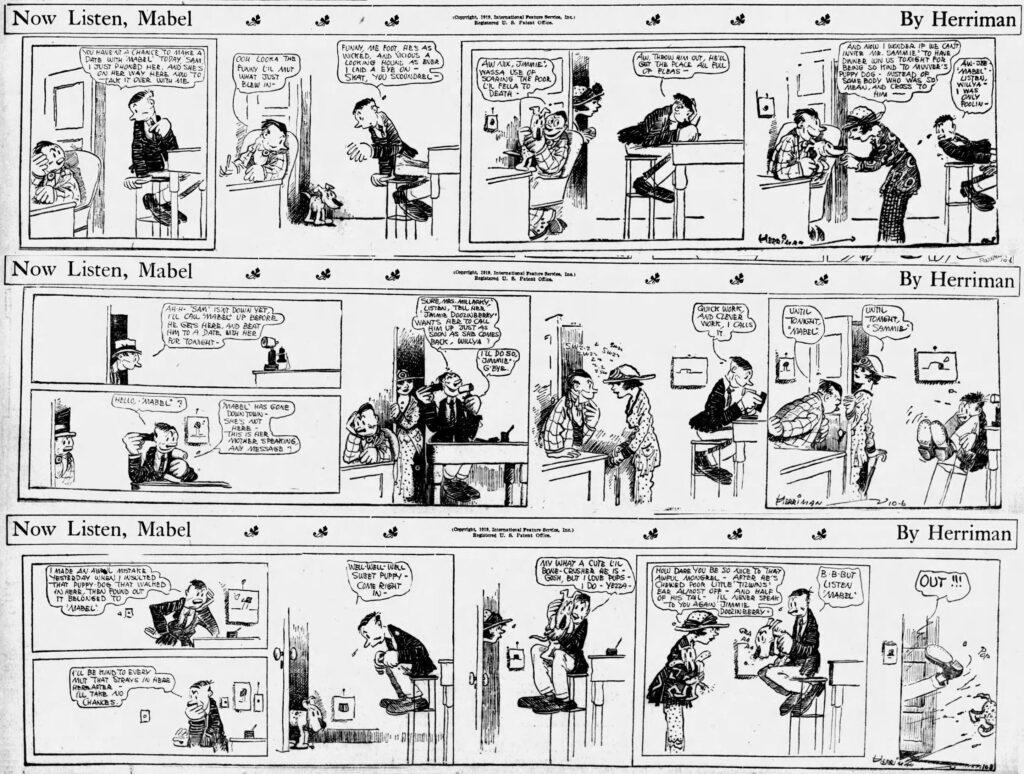 Ji
Ji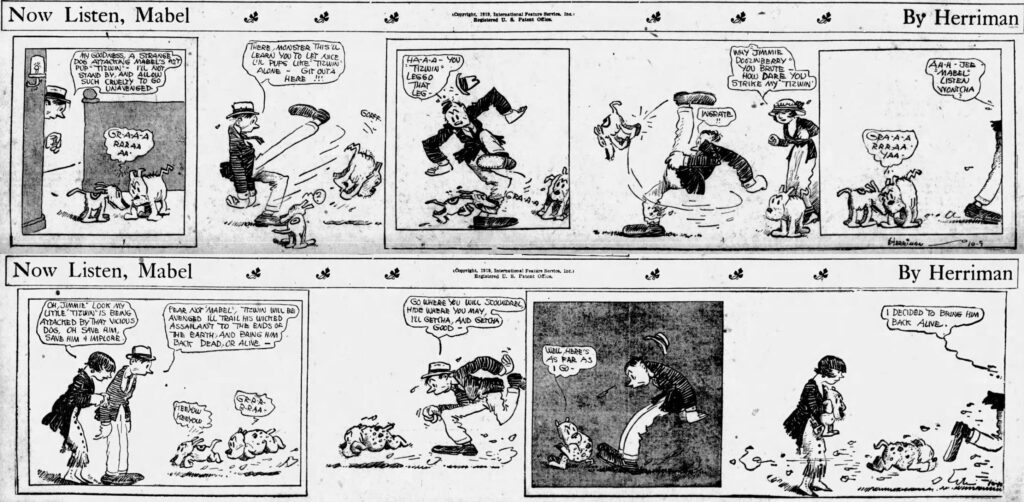
Mabel and Jimmie match wits and dating success as Jimmie tries to prove that he loves Mabel’s pup, “Tizwin”, when he really dislikes dogs. Did people really kick dogs around with such alacrity in 1919? In 1912, a popular song called “They Gotta Quit Kickin’ My Dog Around” or “The Missouri Dog Song” was recorded for Victor. If you search for it, you can hear it, the lyrics are not easy to figure out. I’m sure the song was well remembered in 1919, and perhaps Garge used dogs and shoes as a nostalgic reminder of those canine kickin’ days. These strips are from Oct. 5th through Oct. 10th, 1919 with the strip from Oct. 7th missing. The San Francisco Examiner printed these all mixed up and out of date sequence, so I tried to restore order to them. The dogs in “Now Listen Mabel” don’t speak in anything but “grrrs”, “rowrs” and “Graaa”s. English is reserved for dog conversations in “Krazy Kat”. Remember to pass your mouse over the images until you get a menu that has the item: “Display Image in New Window”. Click on that, and you will be able to see the strips in a different window and displayed larger. If they are not immediately larger, just click on them with your mouse. Enjoy these for now, Mark
Felix Goes Back (to 1932)
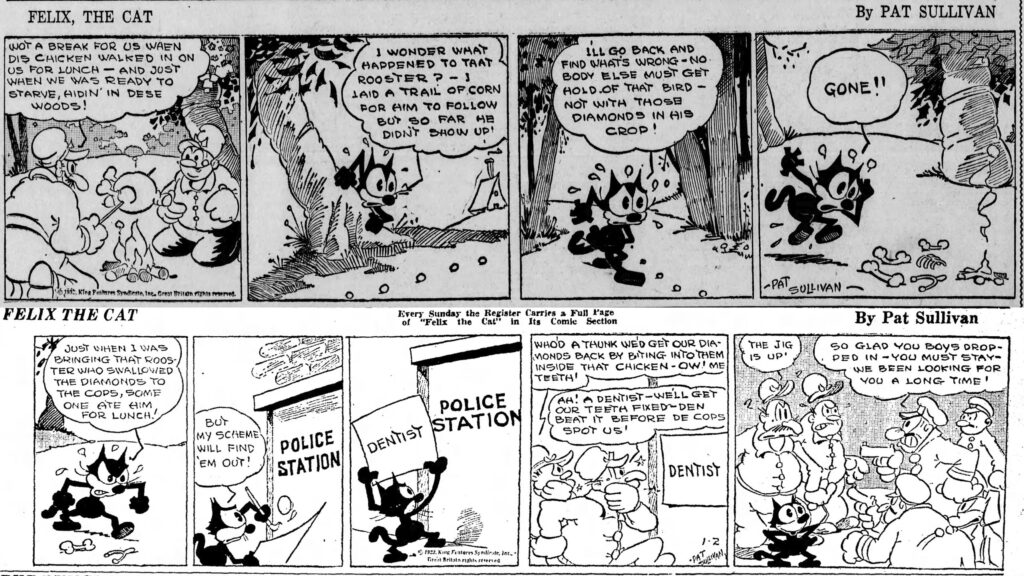
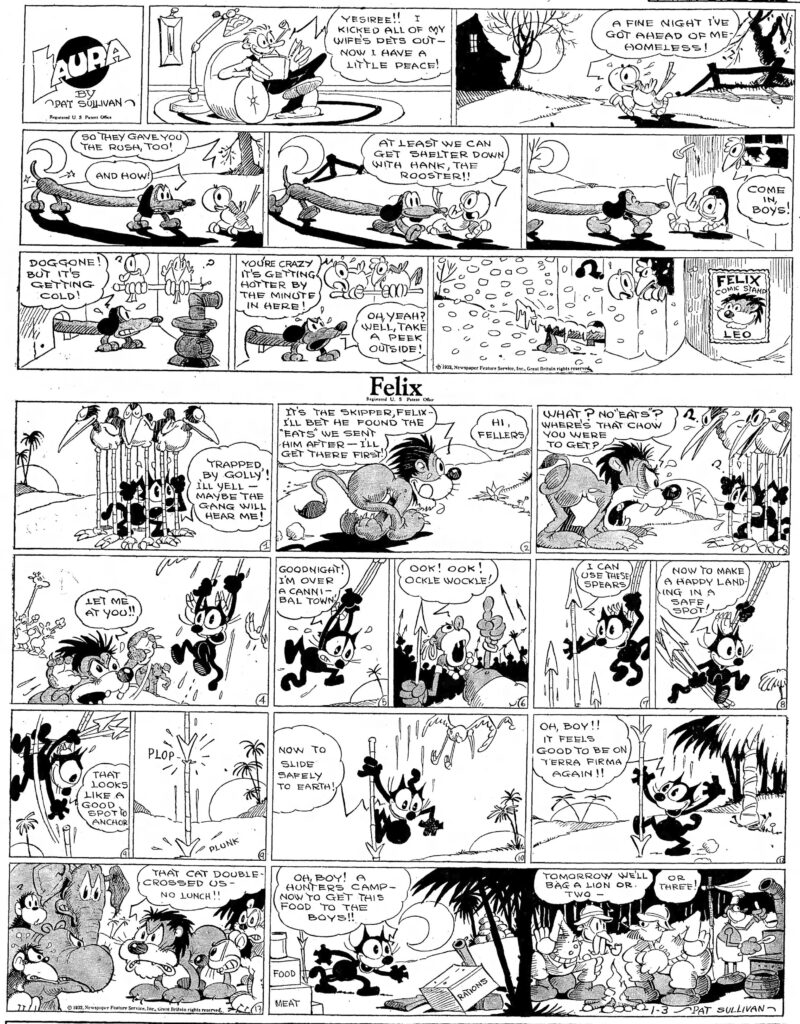
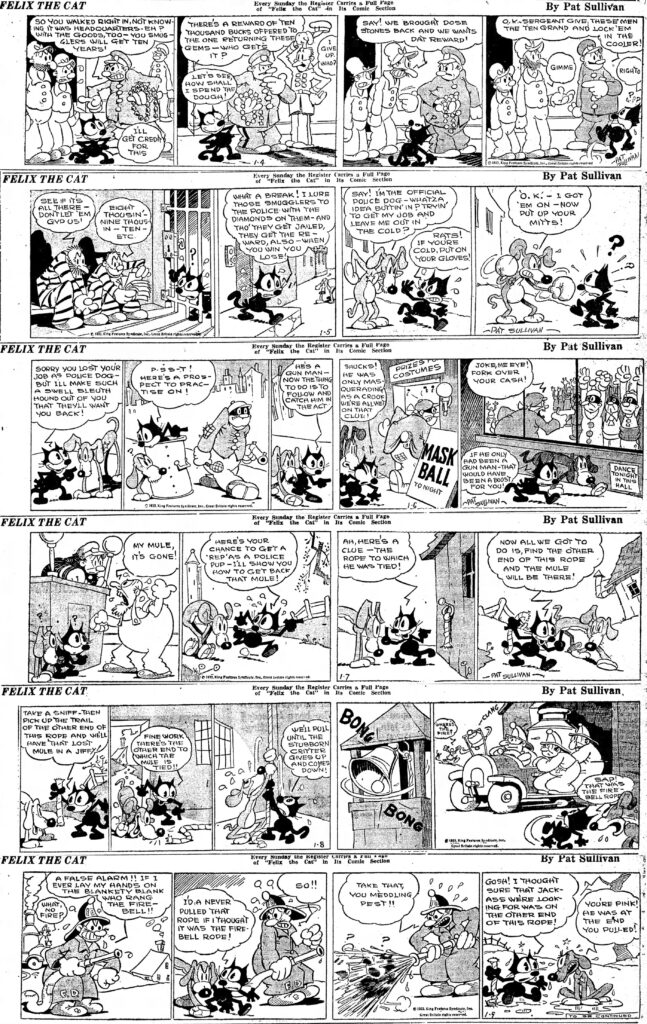
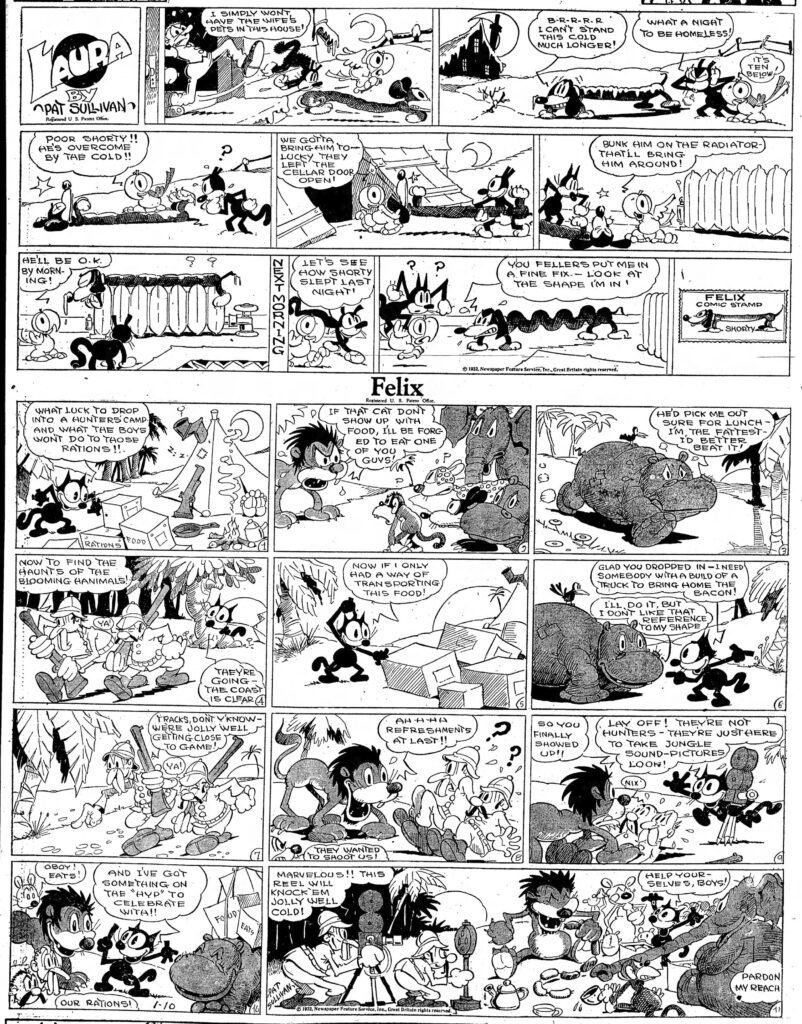

As promised, here are the Felix strips from the first two weeks of January, 1932. The model of Felix used in these comics has to be one of my favorite cat designs. His fingers are square, his knees are pointy, his torso looks like a miniature bowling pin, and his ears go high up off his head and end in points. I love how Otto shows the bottom of Felix’s feet and the Sleuth Hound’s feet as they walk along in the first panel of the 1-15. If you animated the foot coming forward almost parallel to the ground, the character would stumble or trip over his own shoes (see also the burglar in the second panel of the 1-5). The main story here really starts in the 1-7, as a funny old guy complains to the police captain that his mule is “gone”. Felix decides to train the “Official Police Dog” he met in the 1-5 to become a detective by taking up the mule case. Felix and the Hound keep coming up empty, until they see the imprints of the mule’s shoes on the rear end of a black mule wrangler. We’ll see what happens to Felix in the next exciting chapter in the Adventures of Felix The Cat!
Remember to right-click on the images until you see a menu of instructions. Click on the line saying “Open Image in a New Tab”. When you see that, click on the new tab at the top of your screen. You will then see the image in a new screen with black on both sides of it. Then enlarge the image by clicking on it, or hitting plus or minus on your keyboard. Can you figure that out?
Felix Hits A Milestone

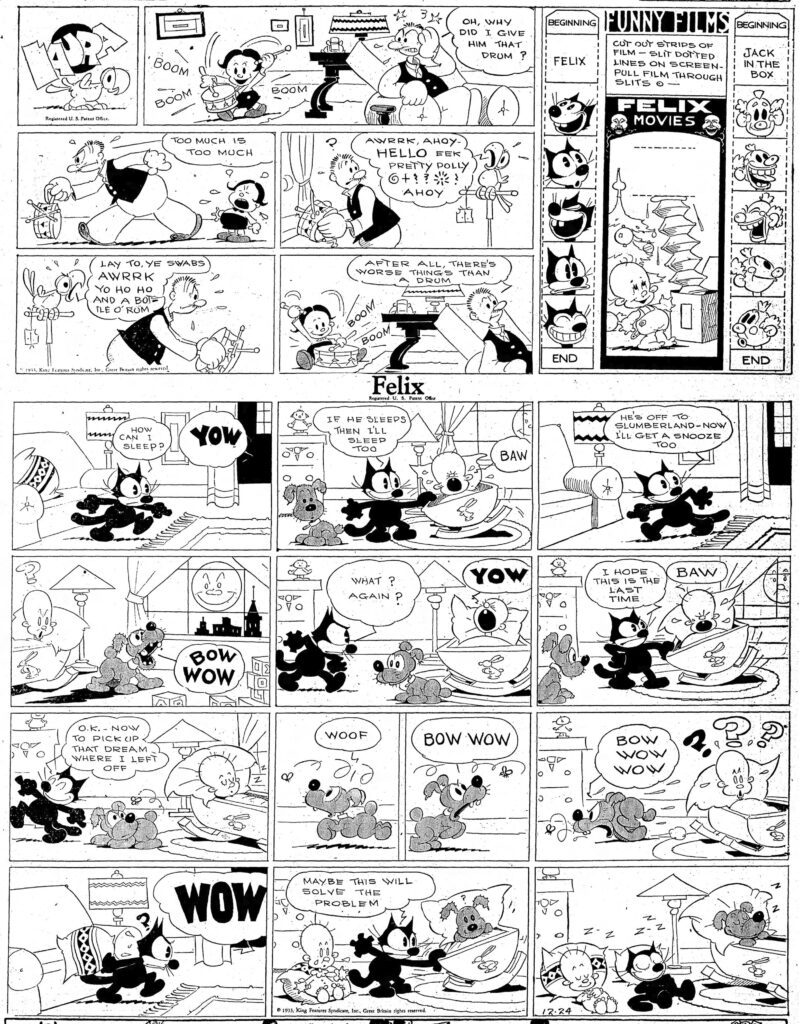

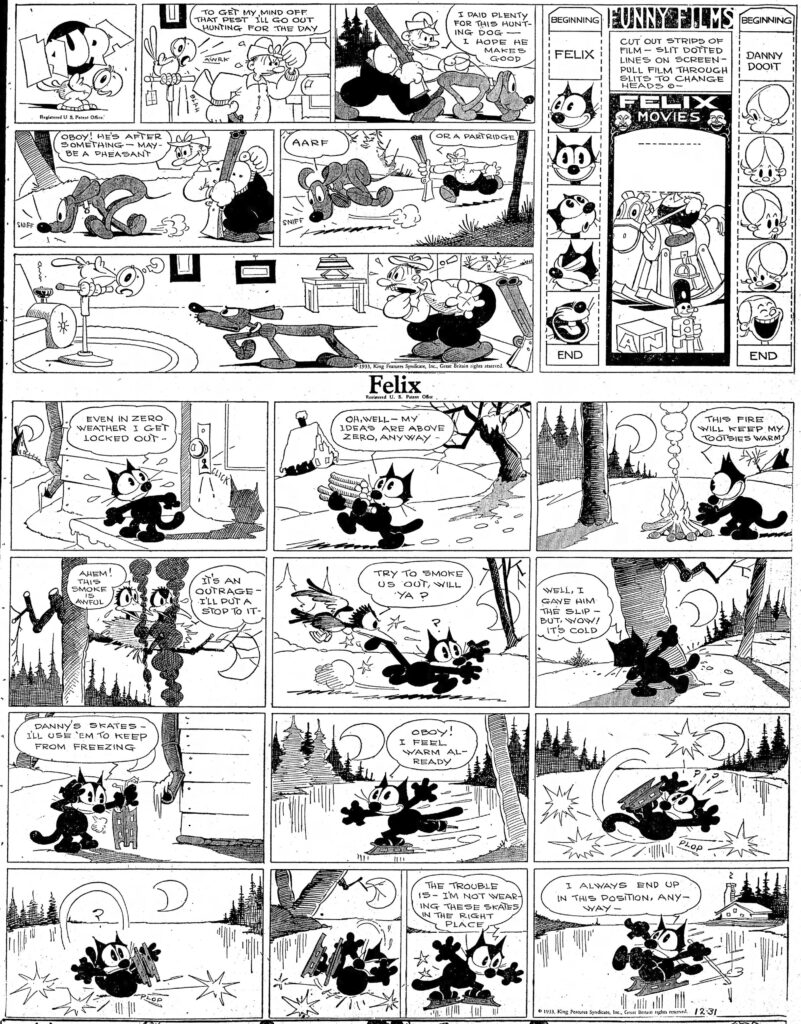
Here’s Felix from 12-18 to 12-31-1933. Felix closes out the year by trying to serve out his time as the millionaire’s mascot. Felix misses Danny and wants to spend Christmas with him, so he tries a lot of tricks to mess up the millionaire’s office so he’ll get thrown out, but nothing works. Then in the 12-29 strip, Felix blows the millionaire’s gold bonds out the office window by turning on a fan accidentally. Danny and his brother are in their back yard cleaning up when they notice the gold bonds have landed right in front of them. If you want to read the rest of the story, find my blog post from 10/1/2013 in the archives, where you will find the Felix strips from 1934. This post concludes the Felix strip from 1933 which I started posting on 3/11/2016. It took SIX years to post the 1933s! Now as before, Felix will magically project BACK IN TIME to 1/1/1932! Look for that in an upcoming post. Don’t forget to right-click the images for the menu which will enable you to open the strips in a new window. There you can blow them up larger so you can read them more easily. Let me say “Thanks” , good readers, for staying with the old Catblog for all these years. Mark
Jimmie’s Sax-o-telephone
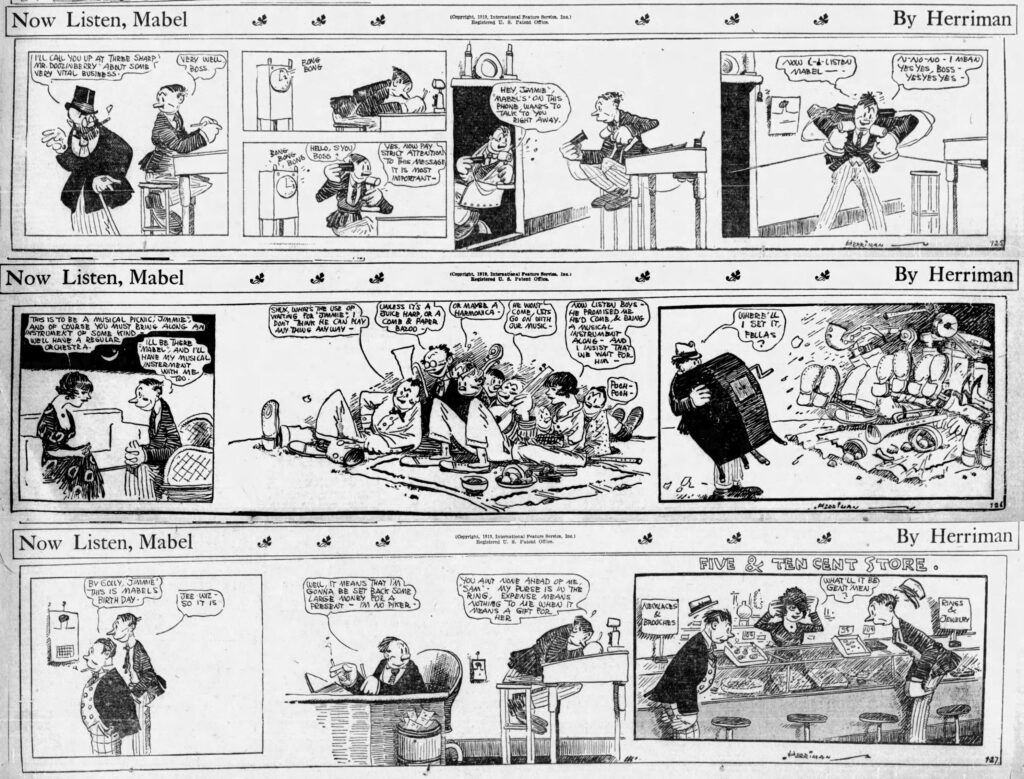

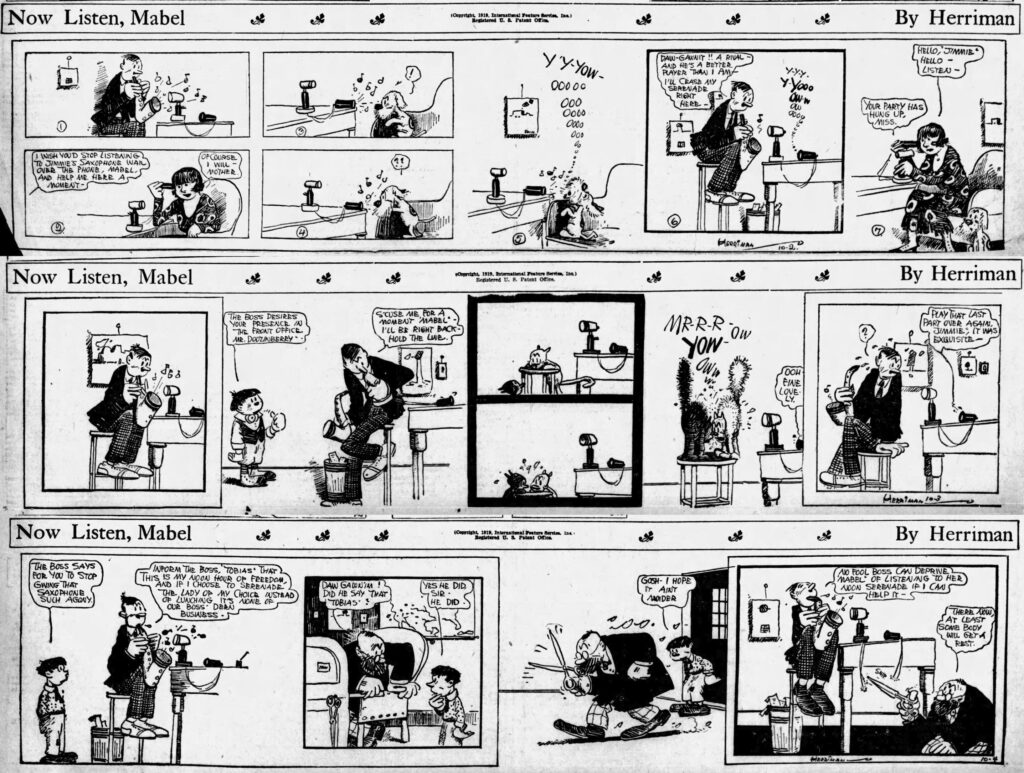
Here’s “Now Listen, Mabel” from 9-25 to 10-4-1919. Starting in the 9-29 strip, Jimmie Doozinberry’s pal butts in on Jimmie’s harmonica serenade over the telephone to Mabel. The office rival uses a saxophone, probably a C-Melody Saxophone, which was in use in the 19-teens and 19-twenties in parlors and small ragtime jazz bands. Frankie Trumbauer, a C-Melody saxophonist and friend of Bix Beiderbecke in the twenties, did some great jazz recordings with the saxophone. It’s very funny in the 10-3, that Mabel prefers the yowling of two pre-Krazy cats to the sound of Jimmie’s sax. It’s interesting that the saxophone was invented by Adolphe Sax in 1842, and is really a brass instrument, like a cornet, with a clarinet mouth piece on it. The saxophone is louder that most other woodwinds, hence it’s versatility used in symphony orchestras and jazz bands. The instrument in the last panel of the 9-26 is a Barrel Organ. That little handle was turned, and a wooden “roll”, similar to a player-piano roll, would rub up against the keys and valves, producing a rather screechy melodic sound. The Barrel Organ dated to 1854, and the gag here is that Mabel and party are expecting Jimmie to show up with a traditional instrument, not a mechanical one. I love Garge’s layout in the 9-26 as well, one long panel in the middle of the group having a picnic, and the first and third panels laid on top of the sartorial scene. I love the design of the office telephone, The mouthpiece has an unusual white cylindrical shape, quite unlike the standard “candlestick” telephone of the era. Dial phones first came in to use in December, 1919, so Jimmie’s office phone would have been operator-assisted dialing.
I hope you enjoy these strips, readers. To enlarge them to full screen, just right-click your mouse on the image, and you should see a “Open in New Window” item in the menu list. Click on that, and you should see the strips in a new widow, much larger. Enjoy, Mark
Mascot Felix Serves the Wealthy
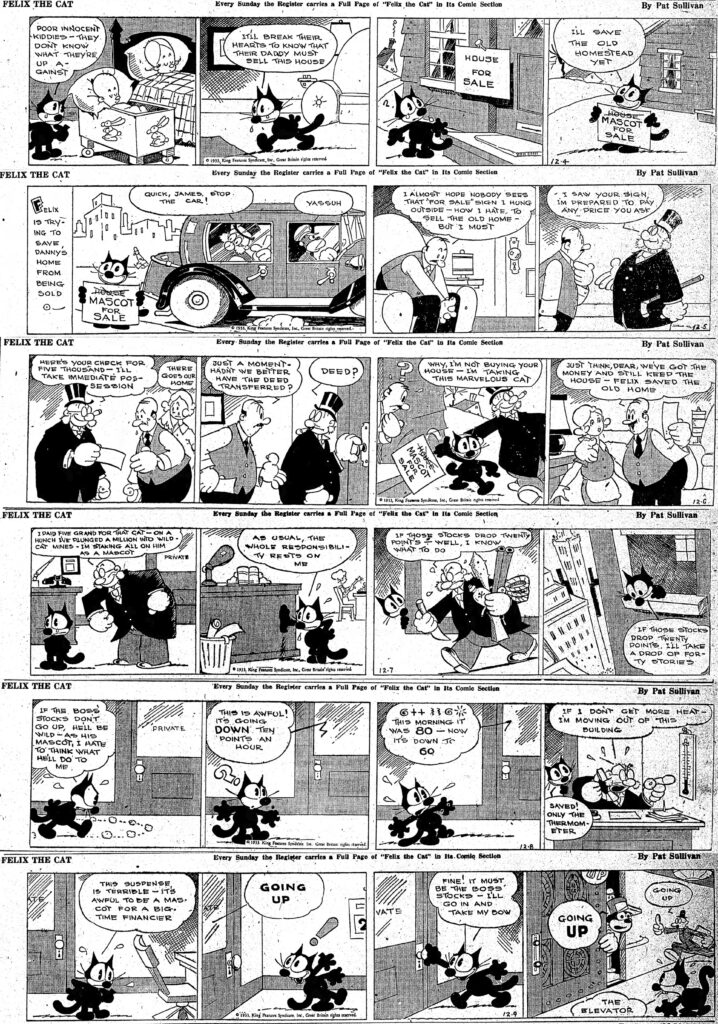
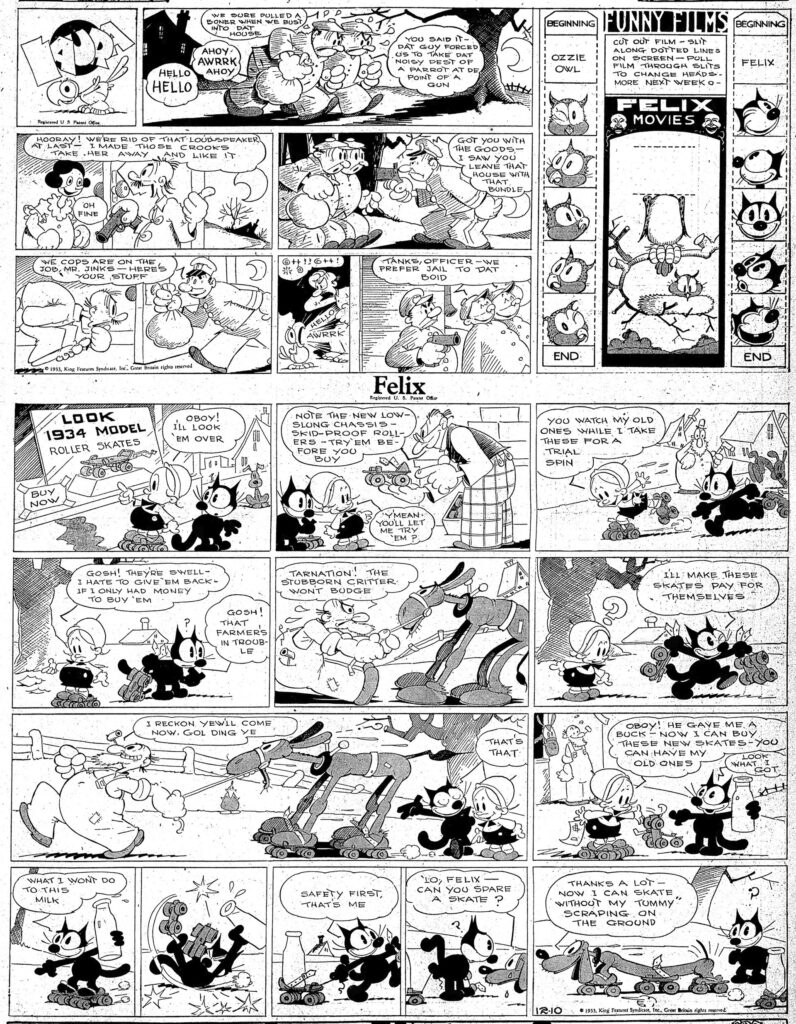
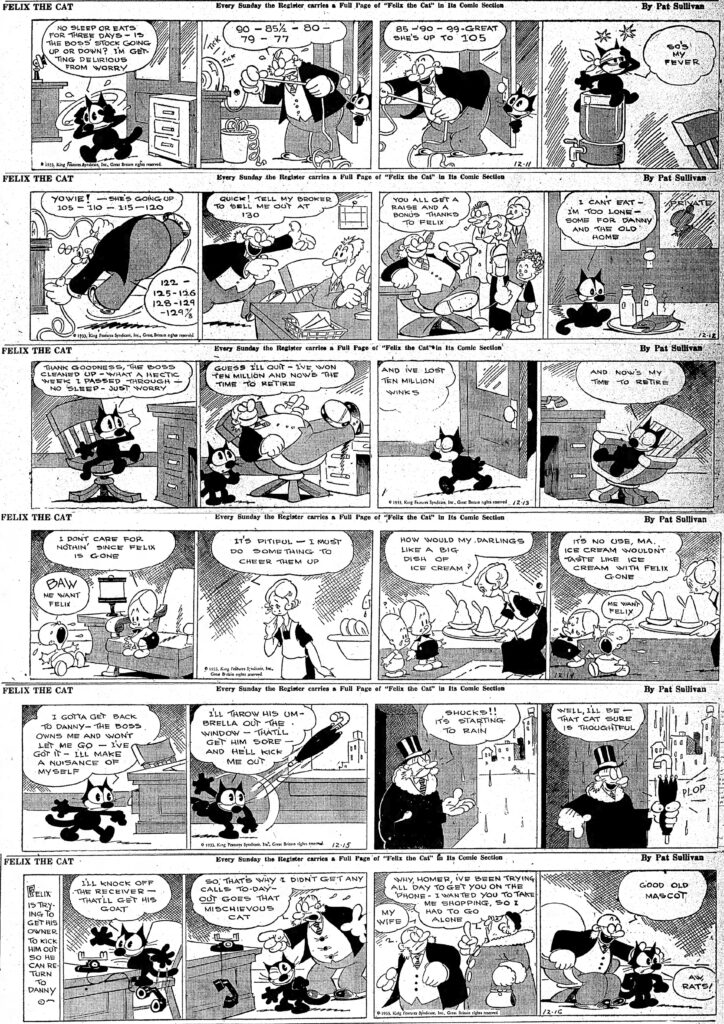
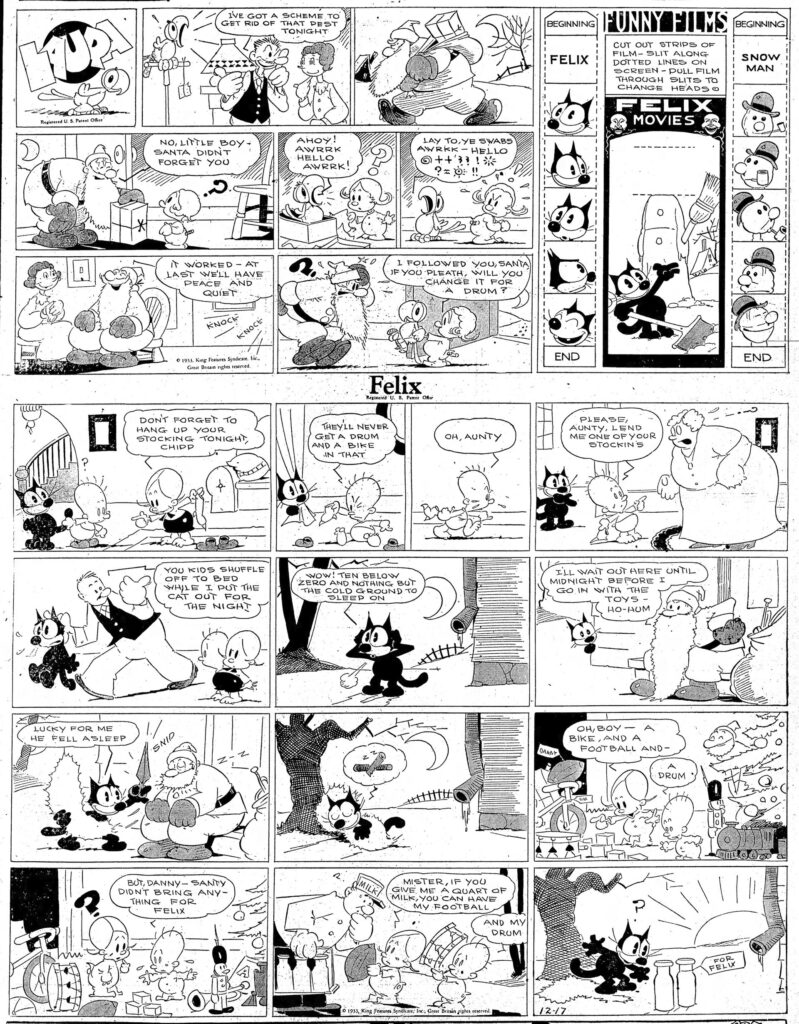
Here’s Felix from 12-4 to 12-17-1933. In the dailies, Felix sells himself for 5K to Homer “The Boss”, a very wealthy stock speculator, preventing Mr. Dooit from selling the family house. Felix is not happy with being Homer’s mascot, but he brings “The Boss” luck, so the Good Luck Cat is in servitude. I like the little poignant touches like the last panel in the 12-12, as Felix has no appetite because he misses Danny and the old house so much. Danny and Chipp miss Felix in the 12-14 so intensely that they declare “ice cream wouldn’t taste like ice cream with Felix gone”. In the 12-10 Sunday page, Otto trots out the old dachshund and the rolller skate bit, and in the 12-17, inspired by O. Henry’s “Gift of the Magi”, Danny and Chipp sacrifice their football and drum in exchange for bottles of milk for Felix. I love panel 9, as Felix gets cozy in Santa’s snipped-off beard. This period of the Felix strip is just about the peak of Otto’s 1930s style, strong blocky shapes for the humans, and a few simple circles for Felix’s body and head. Enjoy these, thanks for your letters! Mark
“Dagwood” Doozinberry
 Here
Here
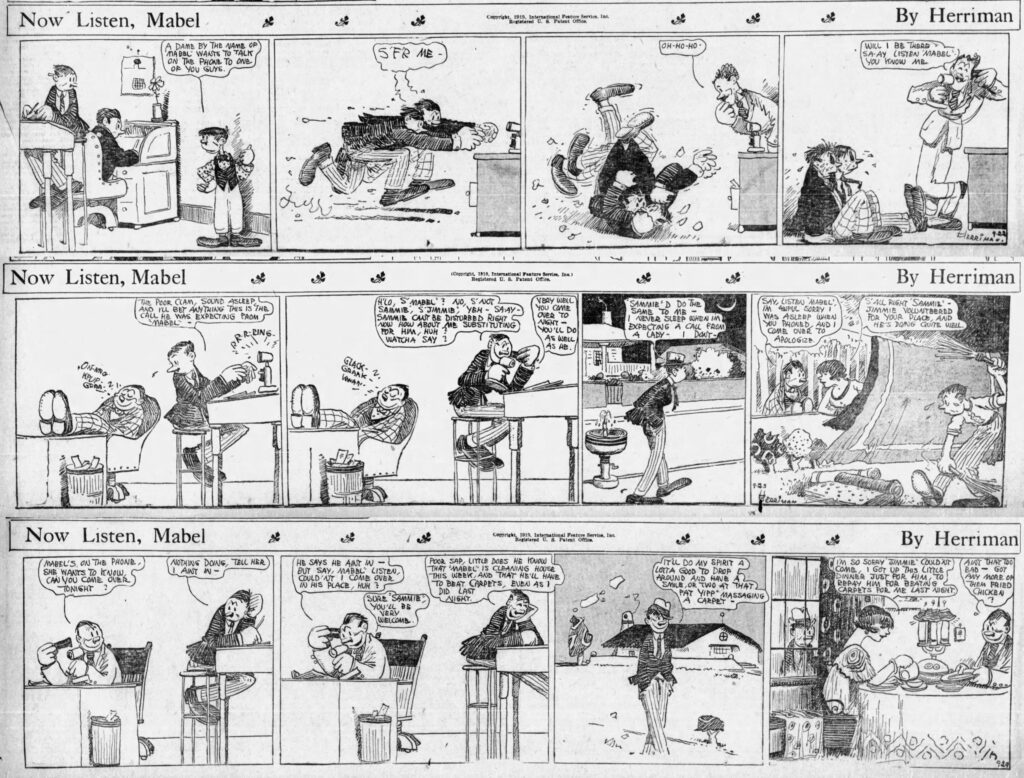
Here’s “Now Listen, Mabel” from 9-18 to 9-24-1919. “Mabel” seems to me like a forerunner of “Blondie” in the early 1930s when Blondie and Dagwood were courting. The 9-20 strip is especially close to the writing in “Blondie”, as Mabel seems determined to spend all of Jimmie Doozinberry’s money, even at a tea date for two! Also the 9-24 has a Chic Young situation, as Mabel winds up with “Sammie” at a thank-you dinner she is supposedly throwing for Jimmie. Mabel is not quite the ditz that Blondie was in the early 1930s, however. She seems just a bit craftier, and is more deliberately playing the field. I also like the way Garge depicts office life in 1919, with simple desks all grouped together in a big room, no partitions or cubicles in those days. The big boss was the only guy who got an office with a closable door.
Magnifying these images is still a bit of a chore. But there may be a “built in” magnifier in the blog, just pass your cursor over the images and they “may” enlarge in a small window to the right of the comics. If that doesn’t work, just open them in a new window. You know how, don’t you? Enjoy!
Felix Goes Under the “Blanket Code”

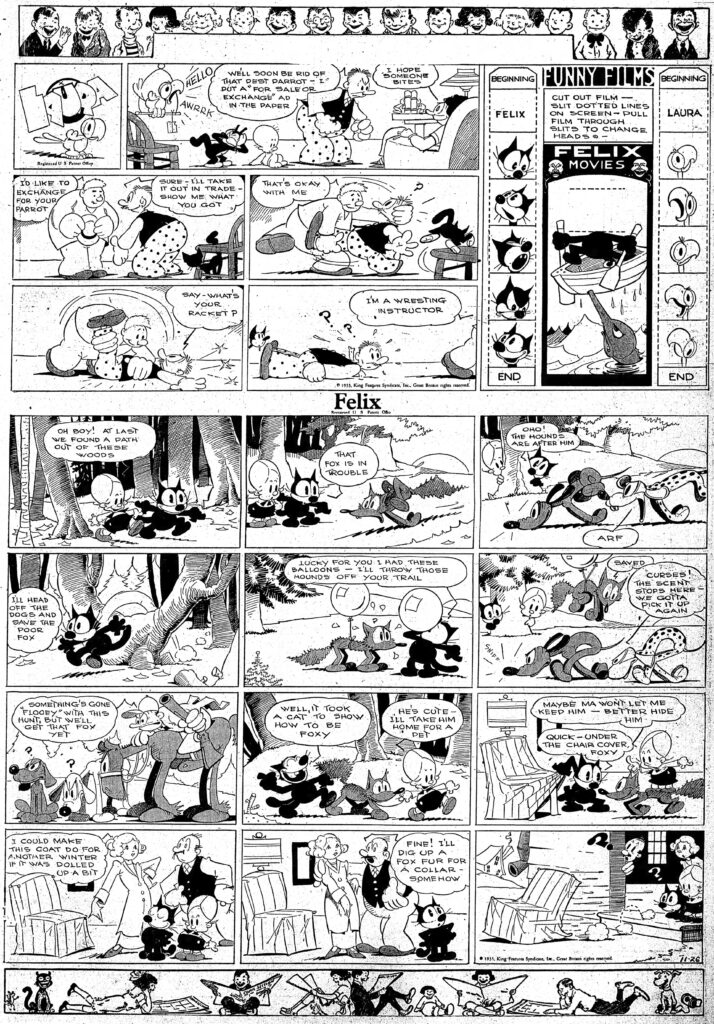
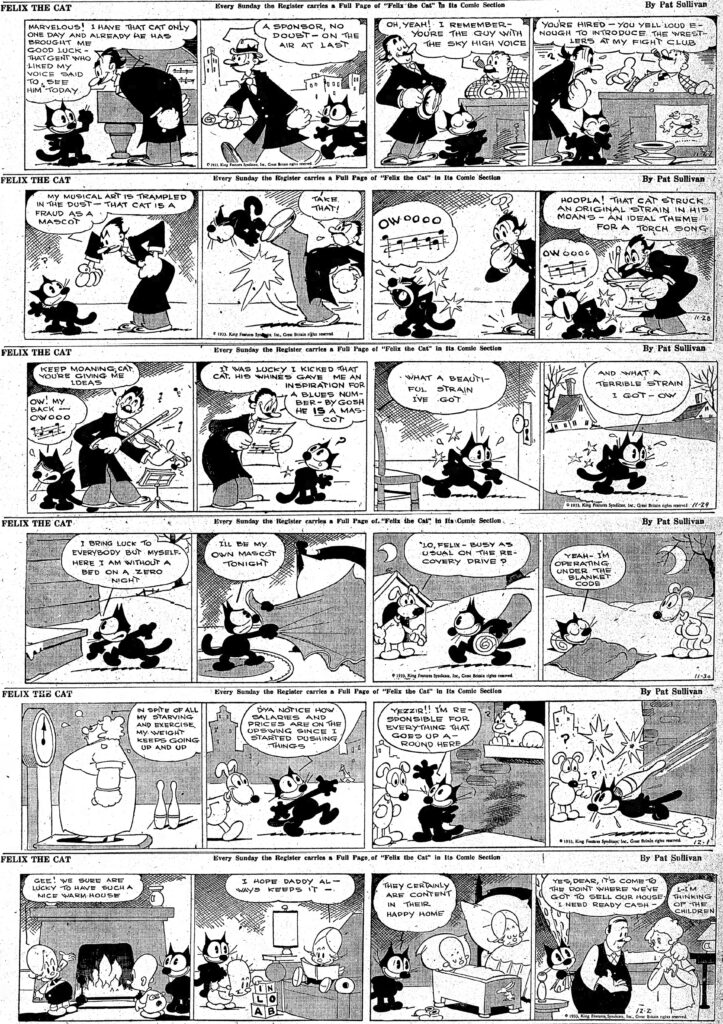
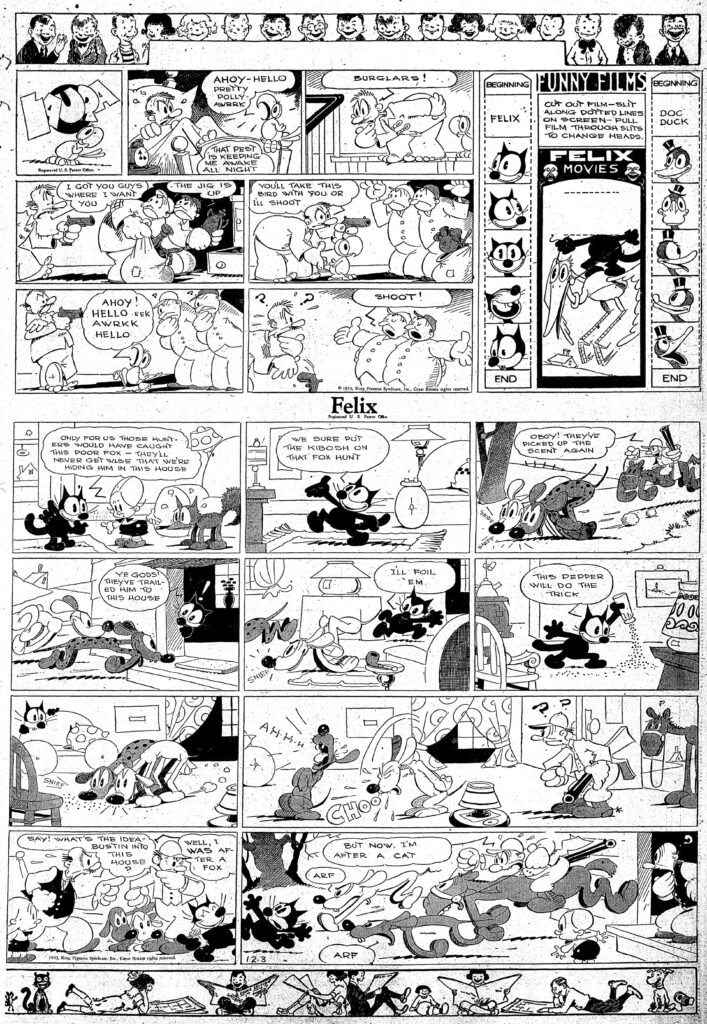
Felix this time is reprinted from 19331120 to 19331203. Felix is once again hired out as a mascot to Mr. Doremi Fasola, the Operatic “Barren Tone”. Mr. Fasola cruelly kicks poor Felix, resulting in yowls and moans that sound like music to Fasola. In the 11-30 and 12-1 strips, the Depression really comes to the fore. In the 11-30, a dog remarks to Felix: “..busy as usual on the recovery drive?”, to which Felix replies, “Yeah, I’m operating under the blanket code”. The Blanket Code was an early version of the National Recovery Re-employment Act, which was generally adopted in July, 1933. Among other reforms, such as making child labor a crime, it set minimum wages at between .35 to .40 cents an hour in most jobs. It’s hard to even conceive of wages that low in our inflated age, but that’s what they were. By August 1933, the NRA code “Blue Eagle” signs were printed and posted in merchant’s and employer’s windows to show that they honored the minimum wage standards and the other labor standards covered in the Blue Eagle guidelines. These helped put a floor under the plunging economy in the mid-1930s. By the end of the thirties, the Blue Eagle was no more, ruled unconstitutional by the Supreme Court. You can look it up. In movies of the 1930s, you will often see the NRA Blue Eagle at the beginning and end of a feature picture. In the Sunday pages, Felix and Danny emerge from the woods and their adventures with the bear family, to intercept a little fox being chased by hounds. Felix shows his cartoon license and breathes in oxygen and exhales helium in to balloons which he attaches to the little fox, lifting him out of the hounds’ path. The fox has one word of dialog: “Saved”. In the 12-3, Felix distracts the hounds with pepper, but the huntsman decides to pursue Felix instead of the Fox. If you want to see the comics larger, just pass your mouse over the comics and right-click to reveal the command: “Open image in new window”. When you have a new window with the comic in it, you can enlarge it and read it more easily. Enjoy!
Now Listen, Mabel Strips
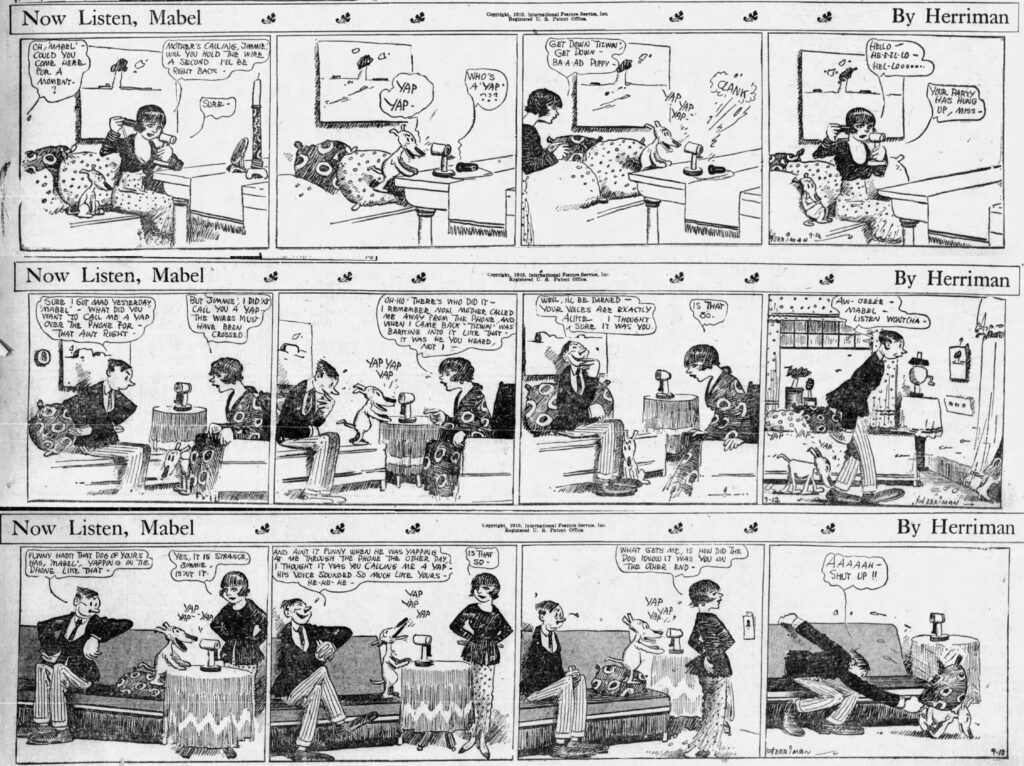
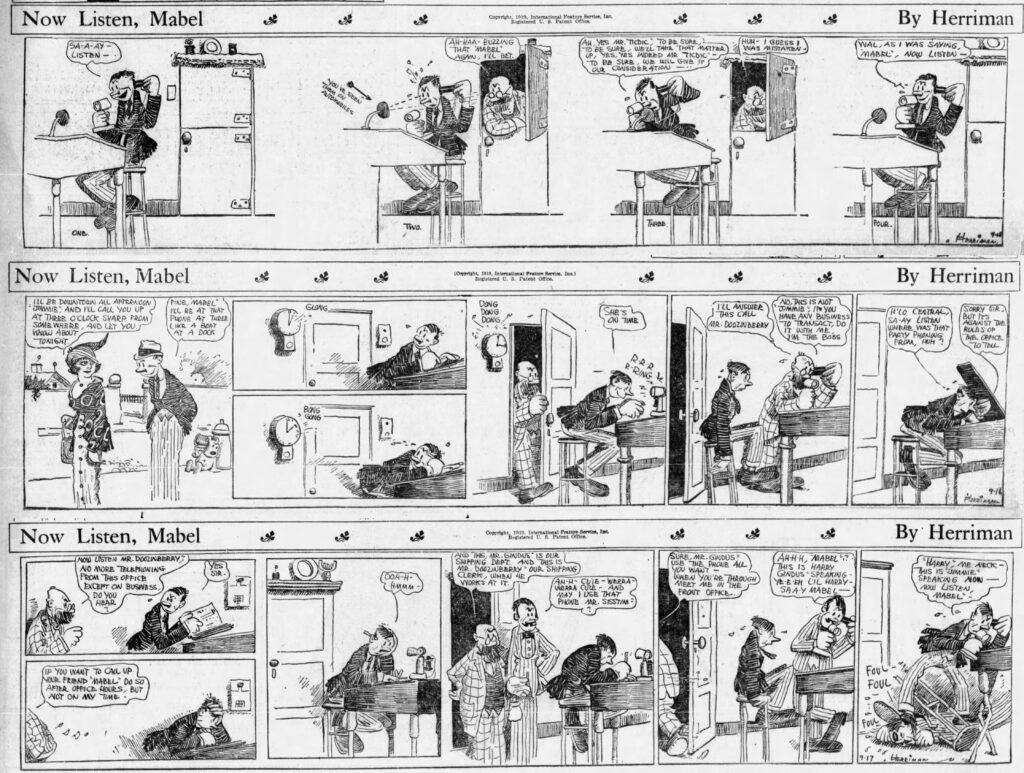
Here are the next six “Now Listen, Mabel” dailies from the pen and knife of George Herriman, 9-11 to 9-17-1919. 9-11 through 9-13 introduce Mabel’s dog “Tizwin” who barks at Jimmie accidentally through Mabel’s telephone. When Jimmie tells Mabel that Tizwin sounds just like Mabel over the telephone, she gets irritated and walks out on him. Mabel tosses the insult back at Jimmie in the 9-13. In the 9-15 through 9-17 strips, Jimmie keeps trying to talk to Mabel on the office telephone much to the disgust of his boss. In the 9-17 strip, Jimmie is introduced to Mr. Gindus (where is Garge getting these character names?), who seems to be another supervisor. Gindus intercepts a call to Jimmie from Mabel, but Jimmie handily steps on Gindus’s head, saving his bacon with Mabel.
I still need advice on making these strips clickable in Word Press. I tried using Classic Editor and Block Editor to edit the pictures, and tried various sizes and uploads. None of that worked, you now have to use your mouse to make the images appear in another window, where you CAN make them bigger. If anyone can help me figure this out, I would be very appreciative. Thanks for reading!
Felix Saves Everybody but Himself
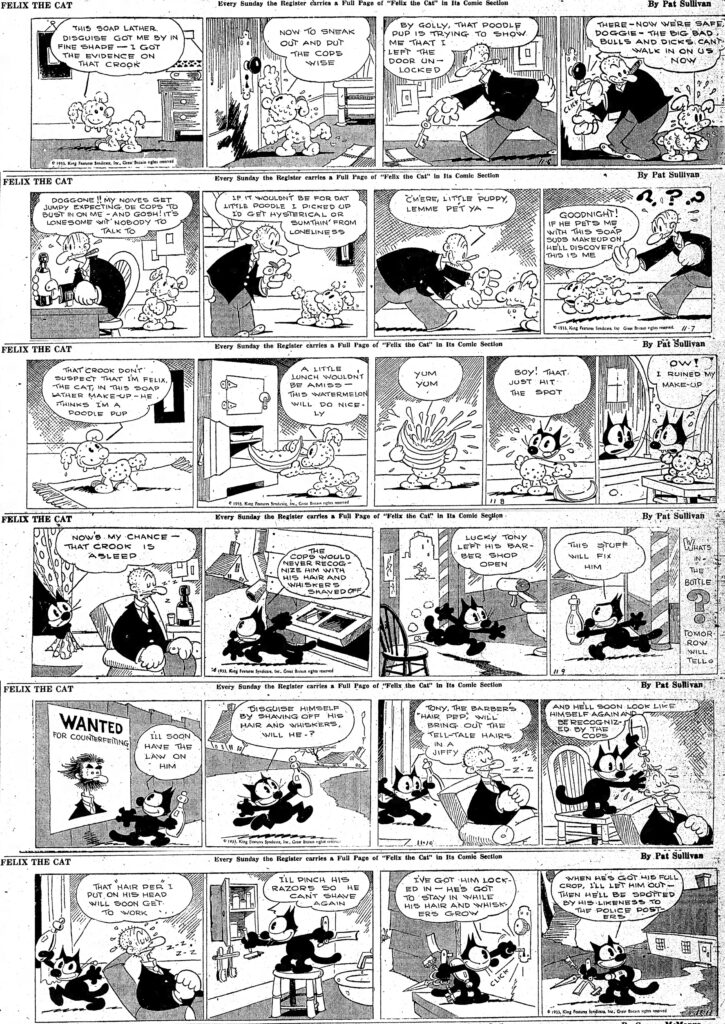 Â
 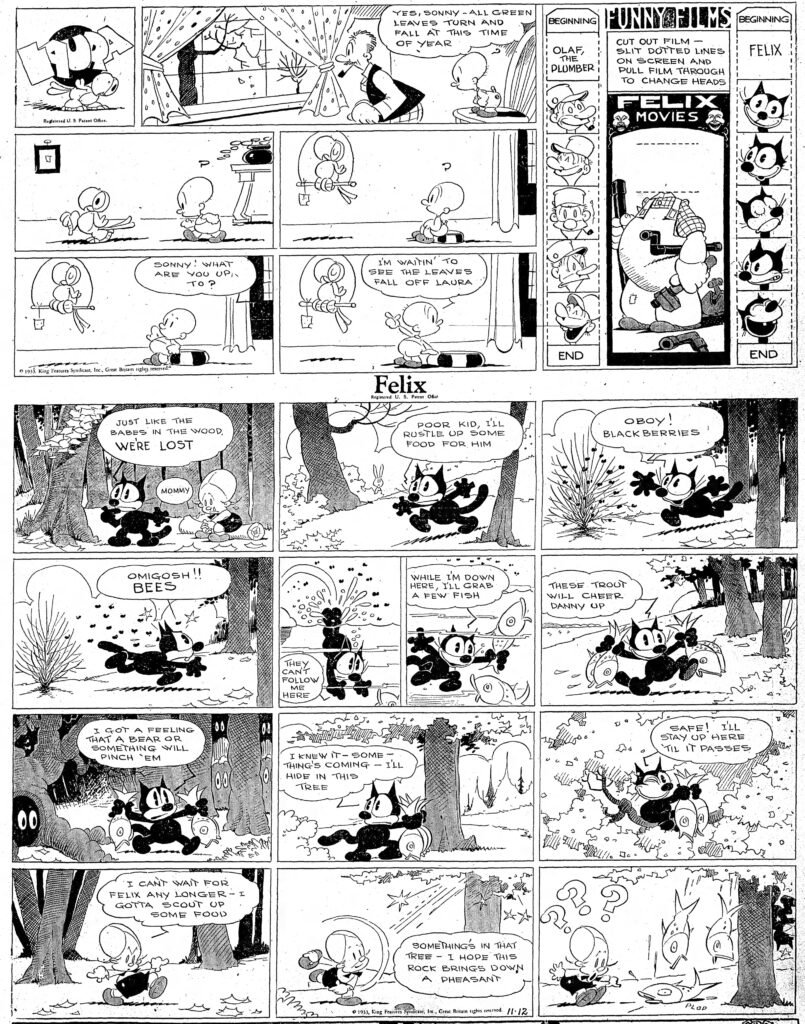
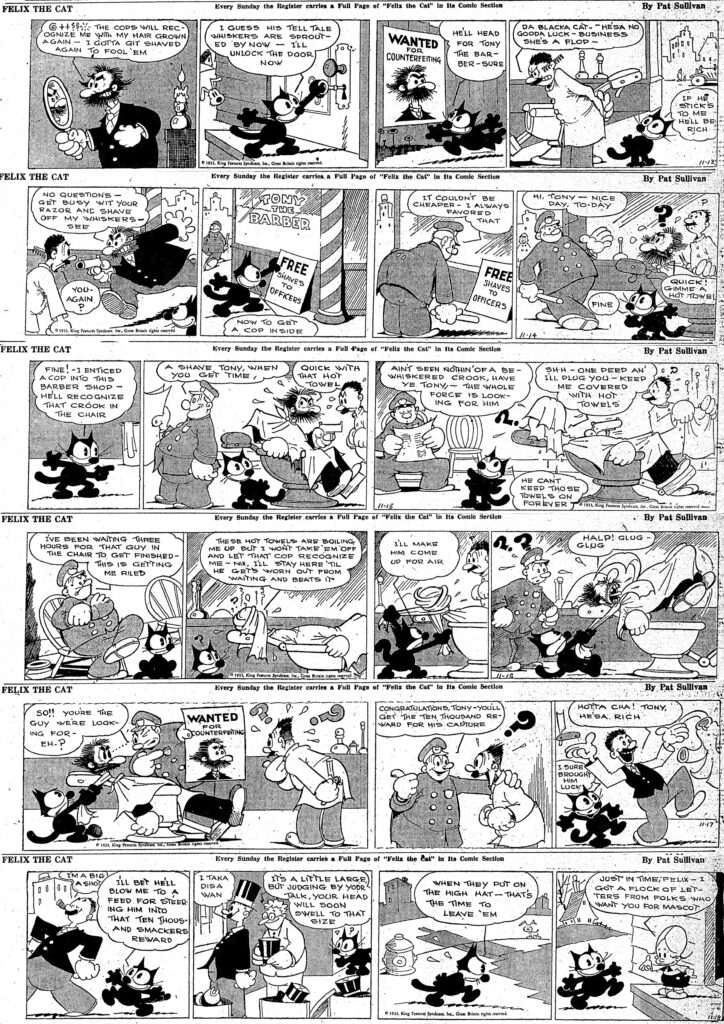
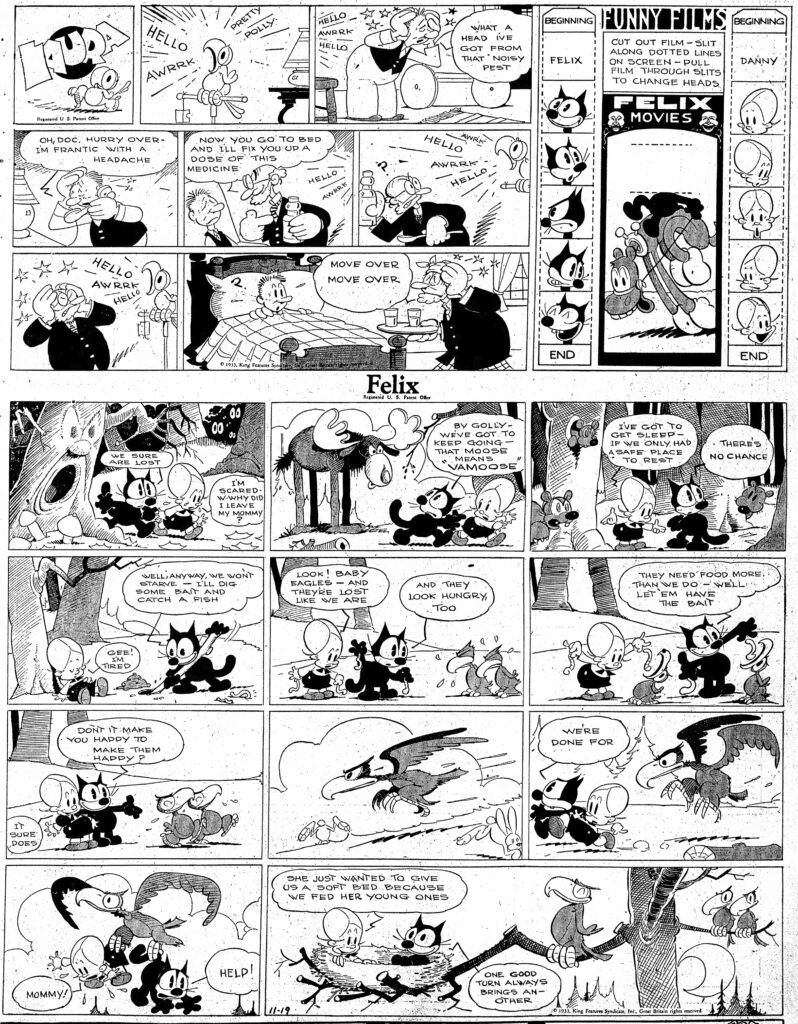
Here’s Felix from 11-6-1933 to 11-19-1933. In the dailies, Felix shows his savvy as he completely foils the counterfeitter. After Felix forces the bad guy to re-grow his whiskers, Tony the Barber gets the $10K reward and goes out to buy new clothes, completely ignoring Felix. In the 11-18, Felix makes a key statement: “When they put on the high hat—that’s the time to leave ’em.” Felix doesn’t even get a reward, he’s on to a new assignment as a mascot. Obviously he is not a fan of the wealthy classes. In the Sundays, Felix and Danny Dooit continue their adventures lost in the woods. Felix tries to feed Danny with fish he grabs from the lake. I love panel 8 in the 11-12 as all those eyes stare at Felix, very much like the scary sequence in “Snow White and the Seven Dwarfs”. In the 11-19, Felix and Danny take pity on two hungry baby Eagles and feed them worms that they intended for fish bait. Mother Eagle seems threatening, but instead gives Felix and Danny a soft bed in her nest. “One good turn always brings another,” Felix says. Enjoy these dear readers!
Mabel Returns
December 7, 2022
Comic Strips George Herriman
3 Comments
Mark
Here’s “Now Listen Mabel” from 10-19 to 10-25-1919. They come from the pages of the San Francisco Examiner. Here Mr. Herriman is dealing in silent comedy slapstick, as Jimmie Doozinberry’s rivals for the attentions of Mabel Millarkey (including Jimmie) get tossed out of her front door repeatedly. In the 10-19, Herriman says “We who have ever dealt in gentle humor..”, a well placed caption introducing this knockabout comedy sequence. I love the crazy poses the suitors take as they go sailing through the effulgent ether. “Mr. Bibbles” in the 10-24, wearing the striped coat, is a ringer for Charlie Chaplin, out of his tramp costume. I wonder if George Herriman ever played tennis at the Hearst San Simeon estate with Charlie Chaplin? Make sure and blow these up as large as you can, so you can appreciate the lettering and the pen work of Garge. You know how to do it, don’t you? If not, just click on the image with your mouse and select “Open Image In New Tab”. This should open the selected strips in a separate tab. Within that tab, just click on the image and they will be displayed larger. Nearly as large as the S F Examiner used to run them, which was clear across the page (more than 10 columns wide). Please enjoy the strips and Happy Holidays to you all.